 28/06/2008 15:07 28/06/2008 15:07 |
|
| | | OFFLINE | | Post: 14.090 | Registrato il: 28/08/2005
| Utente Gold | |
|
Posted earlier today in the preceding page:
- Breakaway Catholics challenge papal ultimatum - Reuters reports a statement by Lefebvrian spokesman
claiming their superior Mons. Fellay has answered the Vatican letter 'without responding to its ultimatum'...
Fr. Zuhlsdorf on his blog posts an update citing statements made by Mons. Fellay in a radio interview today
in which he explicitly says 'it is wrong to say [the SPSPX} has rejected the Vatican conditions', rather
that they want to continue with the dialog... Rorate caeli provides a translation of Fellay's relevant statements.
=====================================================================
    Did Cardinal George really say some of the things attributed to him here? If he did, he is being very impolitic, to say the least - and flat out wrong! But then, this is a report from a TV commentator - and we all know how unreliable and loose that can be!
Cardinal George reflects
Did Cardinal George really say some of the things attributed to him here? If he did, he is being very impolitic, to say the least - and flat out wrong! But then, this is a report from a TV commentator - and we all know how unreliable and loose that can be!
Cardinal George reflects
on Pope's visit to U.S.
by Jay Levine
MIDLOTHIAN, Ill., June 27 (CBS) ― Francis Cardinal George invited Chicago area Catholics to join him Thursday in an evening of reflection on Pope Benedict XVI's visit to America.
Cardinal George was at the Pope's side every step of the way. So was CBS 2 Chief Correspondent Jay Levine, who was also at Thursday's speech by the cardinal.
CBS 2's camera was the only one at the cardinal's speech in Midlothian, where he offered a candid take on an extraordinary week.
Pope Benedict XVI arrived in the U.S. as a stranger, welcomed to a country curious about him and his background. But in less than a week, all agreed, the Pope made quite an impression.
The cardinal said, "As he was leaving, I said 'Holy Father, you should be a very happy man as you're returning to Rome.' He said, 'I am.'"
Cardinal George had been at his side the entire trip; his perspective, shared with parishioners Thursday night, was of a kind of transformation as the week went on.
"Each day he seemed more relaxed and more enthusiastic. And finally on Saturday, when he spoke with the young people, there was a dimension to his personality I'd never seen before," the cardinal said. [ Can it be the cardinal never watched video covarage of Pope Benedict's public events before he came to the United States?]
From his first comments to reporters, and throughout the week, the dominant theme was the protection of children -- something Cardinal George said American Bishops had recommended he stress.
" We had to tell him 'Holy Father, you have to speak to this. This is the event that has most wounded the church," the cardinal said. ['We had to tell him'? He started to address the matter on the plane from Rome!]
When the trip ended and Pope Benedict returned to Rome, Cardinal George said he received a message from officials at the Vatican.
"I came to understand that they were surprised at what happened. 'What did you do to him over there in the United States? He's a very different man.' I don't know how long that will last but it made an impact on him as he made an impact on us.'" [But how absurd! Would anyone close to Benedict say that? The trip to the US did not change who the person is - it merely revealed him to those who did not or could not see him for what he is!]
It was almost as if he'd been transformed from the "stern professor" he has often been portrayed as to a compassionate pastor, something which might have an impact not only on his image in America, but on his entire papacy. [Is this Levine's conclusion or Cardinal George's?]
[Modificato da TERESA BENEDETTA 28/06/2008 17:36] |
|
 28/06/2008 16:01 28/06/2008 16:01 |
|
| | | OFFLINE | | Post: 14.091 | Registrato il: 28/08/2005
| Utente Gold | |
|
  THE POPE'S DAY, 6/28/08
THE POPE'S DAY, 6/28/08
The Holy Father met today with
- H.E. Aníbal Cavaco Silva, President of Portugal, with Mrs. Cavaco, and a delegation.
- the Hon. Giovanni Alemanno, Mayor of Rome
- H.E. Leonida L. Vera, Ambassador of the Philippines, on a farewell visit.
- His Holiness, the Ecumenical Patriarch Bartholomew I, and his delegation. Address in Italian.
This evening, the Holy Father presides at ecumenical Vespers in the Basilica of St. Paul outside the Walls
on the eve of the Solemnity of Saints Peter and Paul, at which he will formally open the Pauline Year.
WITH THE PRESIDENT OF PORTUGAL

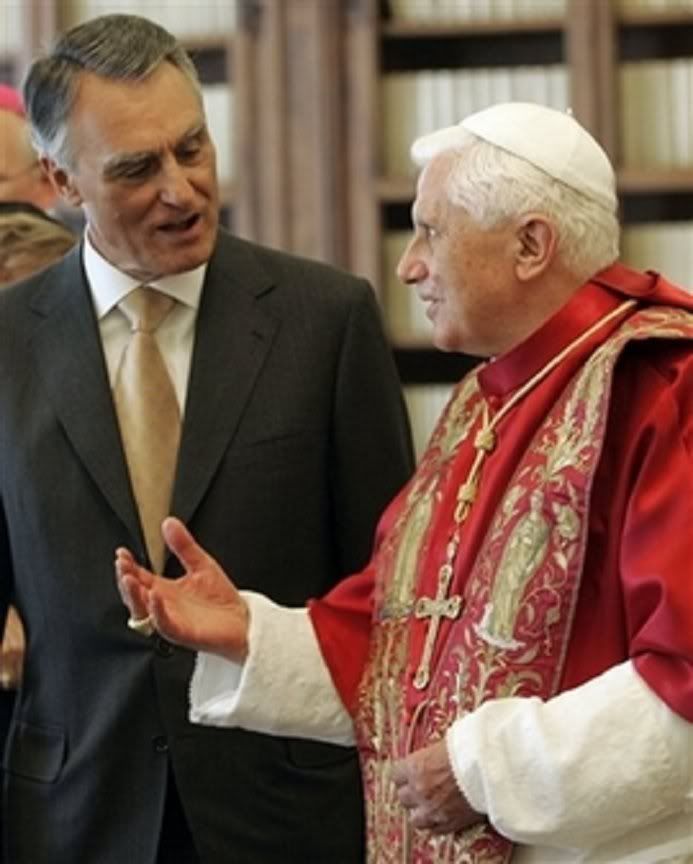
 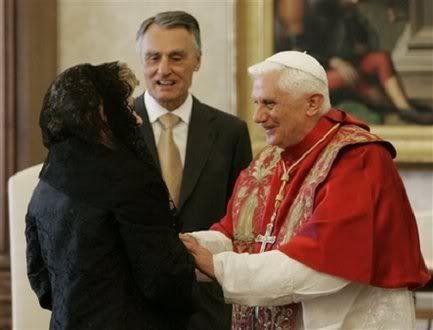
The Vatican Press Office released this communique, translated here:
This morning, the Holy Father Benedict XVI granted an audience to the President of the Republic of Portugal, His Excellency Anibal Cavaco Silva, who later met also with Cardinal Tarcisio Bertone, Secretary of State to His Holiness, and Mons. Dominique Mamberti, Secretary for Relations with Other States.
During the cordial conversations, they reviewed various issues of common interest about the current situation in Portugal. Underscoring the good relations between the Catholic Church and Portugal, they dwelt on the actual applications of the 2004 Concordat between the Holy See and Portugal.
The conversations also touched on some aspects of the international scene today, particularly in Europe, and Portugal's commitment in behalf of some African and Asian nations.
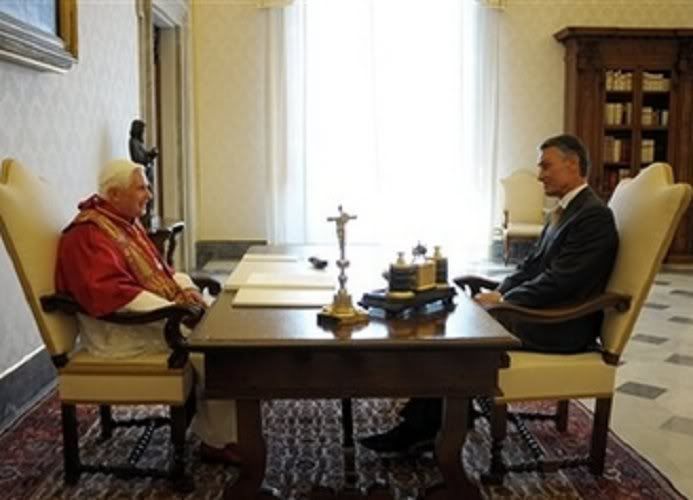
 WITH THE MAYOR OF ROME
WITH THE MAYOR OF ROME
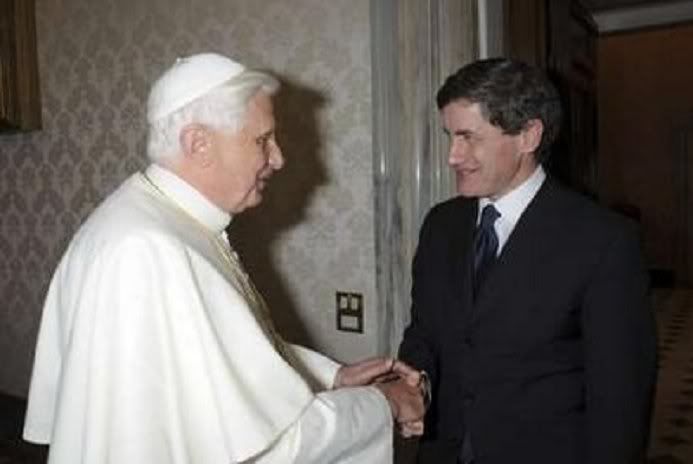 An invitation to address
An invitation to address
the City Council of Rome
Translated from the
Italian service of
 
Among the Holy Father's audiences was one with teh Mayor of Rome,. Gianni Alemanno. During their 45-minute meeting, the mayor invited the Pope to address a special session of the City Council.
Luca Collodi interviewed Alemanno about this shortly before the audience:
MAYOR ALEMANNO: First of all, it is important that this invitation was a bipartisan decision, which included the majority among the opposition party. The order of the day to present the motion was signed by teh party chiefs of the Popolo della Liberta (the party of Prime Minister Silvio Berlusconi adn Alemanno himself], the Partito Democratico [ex-Mayor Walter Veltroni's party, the major opposition today], Italia dei Valori and all the minor groups from left and right. There were only two votes against it, so it was substantially a unanimous invitation, as obviously this could not simply be a partisan invitation. [And who, one might ask, were those two opponents?]
Our intention is to listen to the Holy Father and with him, face the universal role of the city of Rome, which derives from its role as the international center of Catholicism. What better opportunity to do that?
[Earlier stories in the Italian media indicated that the invitation to the Pope was a way of making up for the failure of the previous City Council to come to his support about his right to address an academic convocation at La Sapienza University last January.]
Mr. Mayor, how then does the presence of the Church count for a person who is charged with the responsibility of administering a metropolis like Rome?
This is a city that has another state located within its territory, just as we have within us a strong message linked to the identity of a Church that has clear and definite values which are universally valid. That has to be central from many viewpoints.
The Pope has a new Vicar for Rome, Cardinal Vallini. Have you anything to say to him?
Yesterday I telephoned Cardinal Ruini to express my sentiments at his retirement as Vicar, and today I was able to call Cardinal Vallini to extend my filial greetings. I know that his work, like that of Cardinal Ruini's, will be fundamental for the further development of the city.
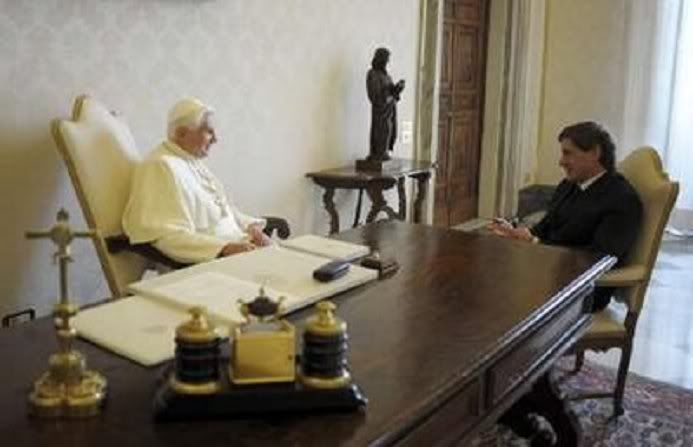 WITH PATRIARCH BARTHOLOMEW I
WITH PATRIARCH BARTHOLOMEW I


[Modificato da TERESA BENEDETTA 28/06/2008 20:10] |
 28/06/2008 16:58 28/06/2008 16:58 |
|
| | | OFFLINE | | Post: 14.092 | Registrato il: 28/08/2005
| Utente Gold | |
|
  'The Pope does not wear Prada -
'The Pope does not wear Prada -
he wears Christ'
An article in L'Osservatore Romano explains the Pope's liturgical choices.
And papal master of ceremonies Guido Marini explains recent decisions by Benedict XVI in liturgical matters.
by Sandro Magister
 For the record, Magister makes the obvious comment that the MSM only picked up the Prada angle in the Vatican newspaper's trilogy of articles two days ago [full translations posted on this thread soon after the articles were posted online] about Benedict XVI's liturgical preferences, and calls attention to the substantive content of those articles.
For the record, Magister makes the obvious comment that the MSM only picked up the Prada angle in the Vatican newspaper's trilogy of articles two days ago [full translations posted on this thread soon after the articles were posted online] about Benedict XVI's liturgical preferences, and calls attention to the substantive content of those articles.
ROMA, June 28, 2009 – "The Pope does not wear Prada, but Christ": this is the blunt conclusion of an article in L'Osservatore Romano two days ago, aimed at defending the decisions of Benedict XVI in his liturgical and other attire. ['Defending'? NO! It was a simple common-sense look at the Pope's thinking that prompts his decisions about his liturgical vestments. The Prada canard was simply a nuisance that needed to be hacked down and buried once and for all!]
Curiously, the article was written by a man with almost the very same name as the famous fashion house, Juan Manuel de Prada.
But there is more in the same issue of L'Osservatore Romano. There is an interview with the master of pontifical liturgical celebrations, Monsignor Guido Marini, who – prompted by a new configuration of the pallium for the Pope – responds to the recurring objections against some of Benedict XVI's recent decisions in liturgical matters: [Does anyone read Mons. Marini's interview as a 'response to recurring objections'? I think it is a disservice to see those articles as a defensive posture by the Vatican! There is nothing to defend. To explain, yes, because the faithful have generally not paid attention to the careful symbolism that is inherent in everything that has to do with the outward signs of liturgy - let alone its nuances!]
– the motu proprio "Summorum Pontificum," which liberalized the ancient rite of the Mass;
– the placement of the cross at the center of the altar, in papal celebrations;
– the Mass celebrated in the Sistine Chapel, on the ancient altar facing the fresco of the Last Judgment ;
– the return to the use of the Pope's pastoral staff crosier in the form of a cross rather than a Crucifix;
– the placement of communion on the tongues of the faithful, kneeling.
On the motu proprio Summorum Pontificum, Marini says that he does not know whether Benedict XVI himself will celebrate in public a Mass according to the ancient rite. And he continues:
«As for the motu proprio cited, considering this with serene attention and without ideological views, together with the letter presenting it addressed by the pope to the bishops of the whole world, a precise, twofold intention emerges. First of all, there is the intention of making it easier to reach 'a reconciliation in the bosom of the Church'; and in this sense, as has been said, the motu proprio is a beautiful act of love for the unity of the Church. In the second place – and this fact must not be forgotten – its aim is that of fostering a mutual enrichment between the two forms of the Roman rite: in such a way, for example, that in the celebration according to the missal of Paul VI (the ordinary form of the Roman rite) 'will be able to demonstrate, more powerfully than has been the case hitherto, the sacrality which attracts many people to the former usage.»
On the placement of the cross at the center of the altar, Marini says:
«This indicates the centrality of the Crucified One in the Eucharistic celebration, and the exact orientation that the entire assembly is called to have during the Eucharistic liturgy: we do not look at ourselves, but we look at Him who was born, died, and rose for us, the Savior. Salvation comes from Lord, He is the East, the rising Sun to whom we must all turn our eyes, from whom we must receive the gift of grace. The question of liturgical orientation in the Eucharistic celebration, and the manner – including practical – in which this takes form, is of great importance, because with it is communicated a fundamental reality that is at the same time theological and anthropological, ecclesiological and inherent to personal spirituality.»
On the celebration at the ancient altar facing the scene of the Last Judgment, in the Sistine Chapel, Marini explains:
«In the circumstances in which the celebration is conducted in this way, it is not a matter of turning one's back to the faithful, but rather of orienting oneself together with the faithful toward the Lord. From this point of view, "the door is not closed on the assembly," but "the door is opened to the assembly," and it is led to the Lord. Particular circumstances can arise in which, because of the artistic conditions of the sacred place and its singular beauty and harmony, it is preferable to celebrate at the ancient altar, where among other things the exact orientation of the liturgical celebration is preserved. This should not surprise us: it is sufficient to go to the basilica of Saint Peter in the morning, and see how many priests celebrate according to the rite produced by the liturgical reform, but on the traditional altars, and therefore oriented like that of the Sistine Chapel.»
On the return to the use of the crosier in the form of a cross, Marini says:
«The golden crosier in the form of a Greek cross – which belonged to blessed Pius IX and was used by Benedict XVI for the first time at the celebration of Palm Sunday this year – is now used constantly by the pontiff, who wanted to replace the silver one with the crucifix at the top, introduced by Paul VI and also used by John Paul I, John Paul II, and Benedict himself. This decision does not simply mean a return to the old way, but testifies to a development in continuity, a rooting in tradition that permits proceeding in an orderly manner on the journey of history. This crosier, called a "ferula," corresponds in fact in a more faithful manner to the form of the papal crosier typical of the Roman tradition, which has always been in the form of a cross and without the crucifix, at least since the crosier began to be used by the Roman pontiffs.»
As for communion placed by the pope on the tongues of the faithful, kneeling – during his recent visit to Santa Maria di Leuca and Brindisi – Marini affirms that this will become "a regular practice at papal celebrations." And he continues:
«In this regard, it must not be forgotten that the distribution of communion in the hand remains, from the juridical point of view, a dispensation from the universal law, conceded by the Holy See to the bishops' conferences that have asked for it. The practice adopted by Benedict XVI tends to emphasize the continued validity of the norm for the whole Church. In addition, one might also note a preference for the use of this manner of distribution which, without taking anything away from the other, better highlights the truth of the real presence in the Eucharist, aids the devotion of the faithful, and makes it easier to enter into the sense of mystery. In our time, pastorally speaking, it is urgent to recover and emphasize these aspects.»
In brief, to those who accuse Benedict XVI of wanting "to impose preconciliar models in this way," Marini rebuts:
«As for terms like "preconciliar" and "postconciliar" that are used by some, it seems to me that these belong to an outdated language, and if they are used with the intention of indicating a discontinuity in the Church's journey, I maintain that they are mistaken and typical of highly reductive ideological views. There are "old things and new things" that belong to the treasury of the Church of all time, and must be considered as such. The wise man is able to find both of these in his treasury, without appealing to other criteria apart from those of the Gospel and the Church. Not all that is new is true, nor is all that is old. The truth spans old and new, and it is for this that we must strive, without prejudice. The Church lives according to the law of continuity in virtue of which it recognizes development rooted in tradition. What is most important is that everything work together so that the liturgical celebration truly is the celebration of the sacred mystery, of the crucified and risen Lord who becomes present in his Church, reenacting the mystery of salvation and calling us, in the logic of an authentic and active participation, to share to the full in his own life, which is a life given in love to the Father and to his brothers, a life of holiness.»
It is beyond doubt that the positions expressed by the current master of pontifical liturgical celebrations faithfully reflect the thought of Benedict XVI. To understand this, it is enough to reopen, for example, a book published by Joseph Ratzinger in 2001: Introduction to the Spirit of the Liturgy.
In that book, Ratzinger wrote that the solution to the many current liturgical "absurdities" is the not that of changing everything again, because "nothing is more harmful for the liturgy than for everything to be turned constantly upside-down."
But about the orientation of the liturgy and of the placement of the cross, he showed that he has extremely clear ideas:
«In ancient times, facing east was closely related to the 'sign of the Son of man' to the cross, which announces the return of the Lord. The east was therefore associated with the sign of the cross.
Where it is not possible for everyone to face the east together in an evident manner, the cross can serve as the 'inner east' of faith. It should be placed at the center of the altar, and should be the spot where the attention of both the priest and the praying community is turned.
In this way, we follow the ancient exhortation pronounced at the beginning of the Eucharist: "Conversi ad Dominum," turn to the Lord. Let us look together to Him whose death ripped the veil of the temple, to Him who stands before the Father on our behalf and holds us in his arms, to Him who makes of us a new living temple.
Among the truly absurd phenomena of our time, I would add the fact that the cross is placed to one side of the altar in order to give the faithful an unobstructed view of the priest. But does the cross represent an annoyance during the Eucharist? Is the priest more important than the Lord? This error should be corrected as soon as possible, and this can be done without any new architectural modifications.
The Lord is the point of reference. He is the rising sun of history. This cross can either be that of the passion, which represents the suffering Jesus who allows his side to be pierced for us, releasing blood and water – the Eucharist and Baptism – or a triumphal cross, which expresses the idea of Jesus's return, and draws attention to this.
Because in any case it is He, the one Lord: Christ yesterday, today, and forever.»
Since then, Ratzinger has not changed his views by one iota. Nor is he silent about them.
Last March 22, in fact, at the Easter Vigil Mass at the Basilica of Saint Peter, Benedict XVI concluded his homily by returning to the exhortation "Conversi ad Dominum":
In the early Church there was a custom whereby the bishop or the priest, after the homily, would cry out to the faithful: "Conversi ad Dominum" – turn now towards the Lord.
This meant in the first place that they would turn towards the East, towards the rising sun, the sign of Christ returning, whom we go to meet when we celebrate the Eucharist. Where this was not possible, for some reason, they would at least turn towards the image of Christ in the apse, or towards the Cross, so as to orient themselves inwardly towards the Lord.
Fundamentally, this involved an interior event; conversion, the turning of our soul towards Jesus Christ and thus towards the living God, towards the true light.
Linked with this, then, was the other exclamation that still today, before the Eucharistic Prayer, is addressed to the community of the faithful: "Sursum corda" – lift up your hearts, high above the tangled web of our concerns, desires, anxieties and thoughtlessness –
"Lift up your hearts, your inner selves!" In both exclamations we are summoned, as it were, to a renewal of our Baptism: "Conversi ad Dominum" – we must distance ourselves ever anew from taking false paths, onto which we stray so often in our thoughts and actions. We must turn ever anew towards him who is the Way, the Truth and the Life.
We must be converted ever anew, turning with our whole life towards the Lord. And ever anew we must allow our hearts to be withdrawn from the force of gravity, which pulls them down, and inwardly we must raise them high: in truth and love.
At this hour, let us thank the Lord, because through the power of his word and of the holy Sacraments, he points us in the right direction and draws our heart upwards.»
======================================================================
Magister then provides links to the original trilogy of articles published in the June 26 issue of OR (and translated in the preceding page of this thread).
Meanwhile, this stunning photograph from Caterina in the main forum shows - besides the Holy Father's amazingly childlike limpidity - the exquisite detail that goes into the crafting of liturgical wear as we recognize in all Church art and architecture offered ad majorem Dei gloriam - in which the objects made by man constitute liturgy in themselves in the sense of ars celebrandi ergo orandi!

[Modificato da TERESA BENEDETTA 28/06/2008 20:37] |
 28/06/2008 20:47 28/06/2008 20:47 |
|
| | | OFFLINE | | Post: 14.096 | Registrato il: 28/08/2005
| Utente Gold | |
|
  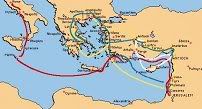 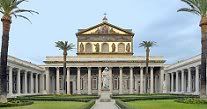  Pope launches year of St. Paul
Pope launches year of St. Paul
with call for Christian unity
 A full translation of the Holy Father's homily and Patriarch Bartholomew's greeting at the Vespers has been posted in
A full translation of the Holy Father's homily and Patriarch Bartholomew's greeting at the Vespers has been posted in HOMILIES, DISCOURSES, MESSAGES.
ROME, June 28 (Reuters) - Pope Benedict called for Christian unity when he joined the spiritual head of Orthodox Christians on Saturday to launch a year dedicated to St. Paul, the evangelist of the early Church born two millennia ago.
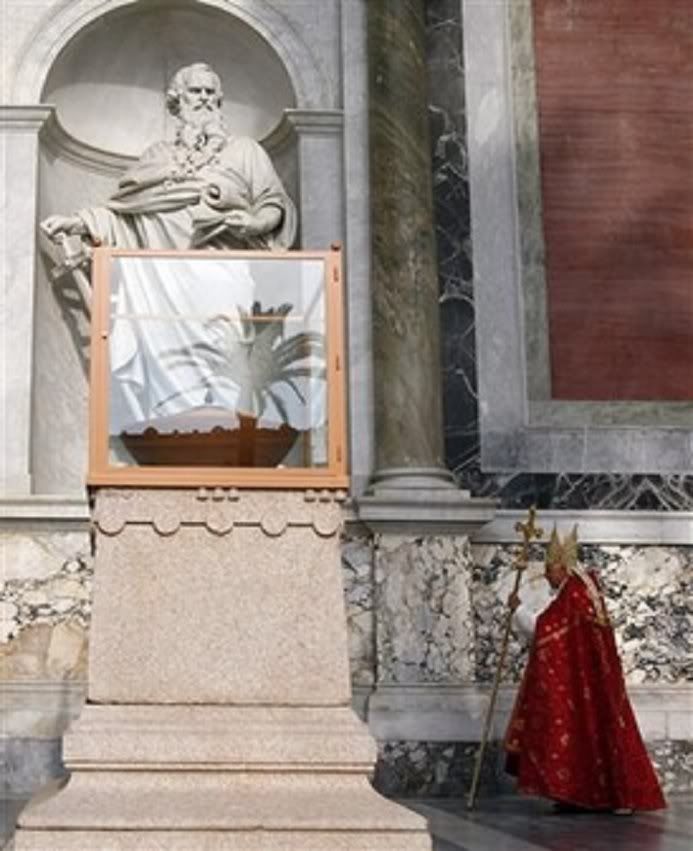

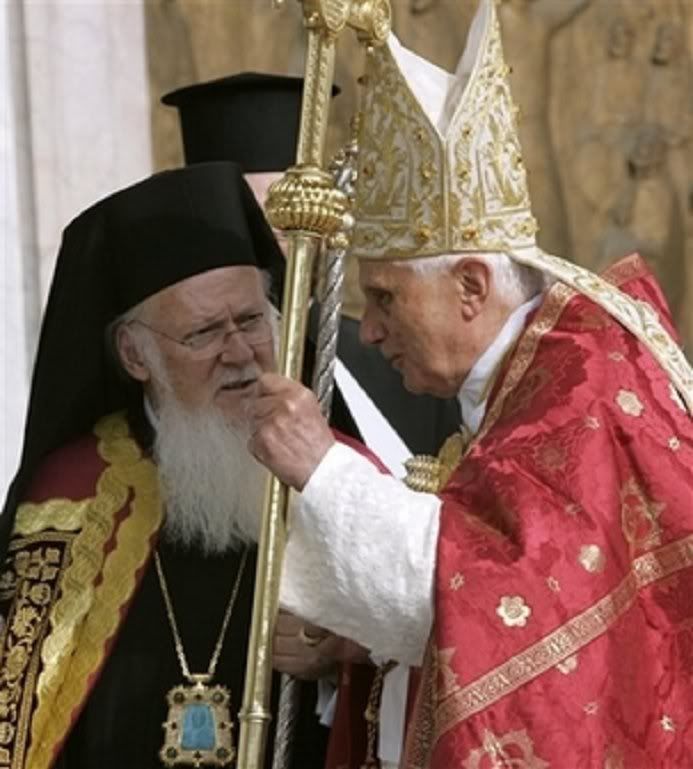
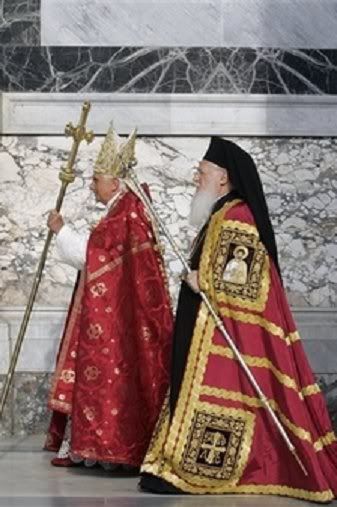 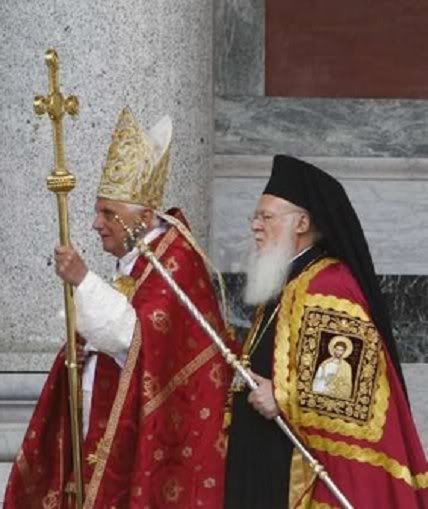

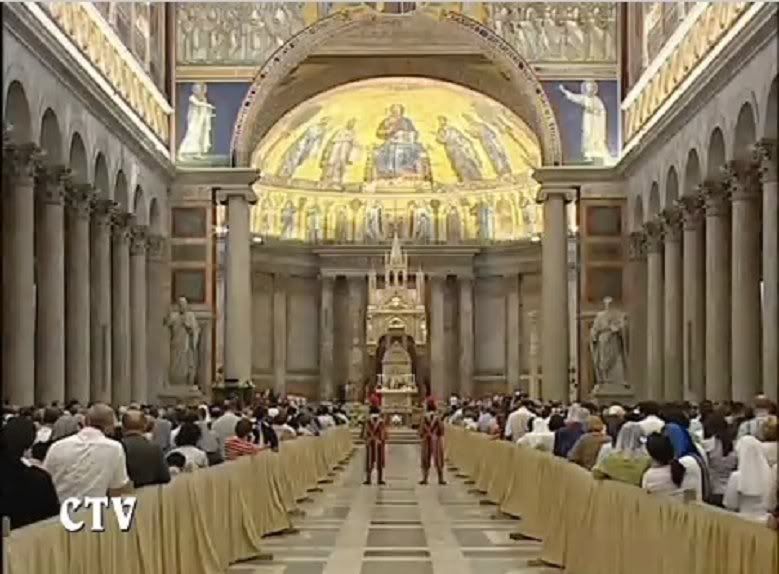
The Pope presided over the ceremony at Rome's Basilica of St. Paul's Outside the Walls, which houses a marble sarcophagus believed to contain the remains of the 1st century apostle.
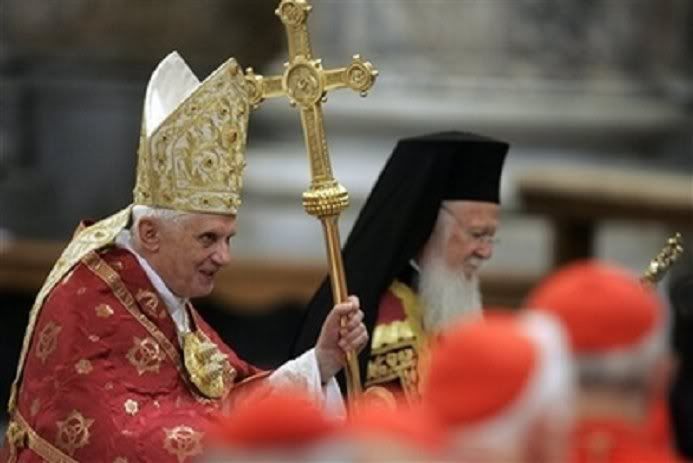
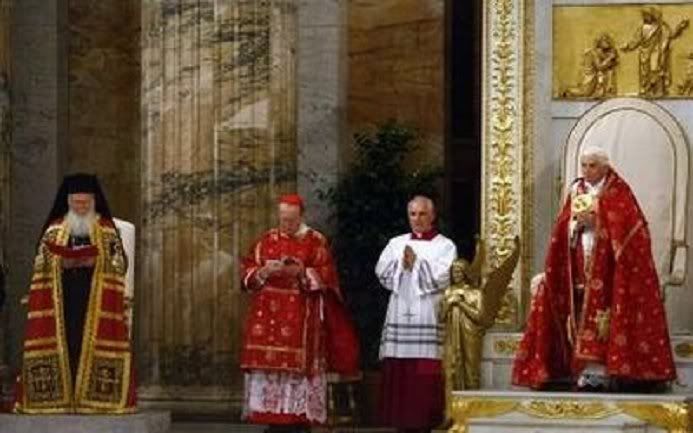
It is the second largest of Rome's basilicas, after St. Peter's in the Vatican.
"We, although being many, are one body only," the Pope said, referring to the ties that unite Christians.
He was joined by Ecumenical Patriarch Bartholomew, the spiritual head of worldwide Orthodoxy, which split from the Roman Catholic Church in 1054.
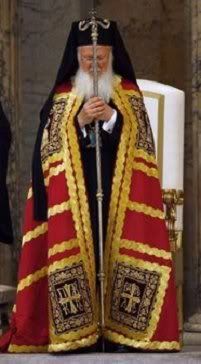 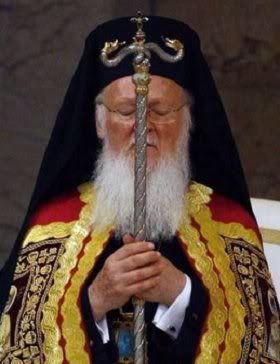 
St. Paul was born in the city of Tarsus in present-day Turkey. He persecuted early Christians but converted when he had a vision on the road to Damascus years after Christ's death and became known as the "apostle to the Gentiles."
According to Catholic tradition, St. Paul was killed for his faith in the 1st century and buried on Rome's Via Ostiense, where St. Paul's Basilica was later erected.
Benedict has met Bartholomew several times with the goal of healing the rift between the Catholic and Orthodox Churches.
"St. Paul reminds us that the full communion among all Christians finds its grounds in a single father, a single faith and single baptism," Benedict said in an address to Bartholomew earlier on Saturday.
 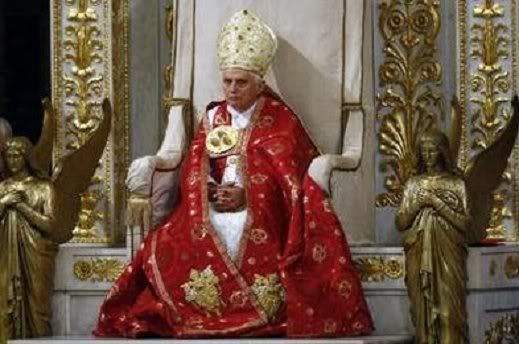 NB#1: Lots of thanks to Shawn Tribe of New Liturgical Movement whose video-caps provide much-needed important shots of the evening's events which the newsphotos generally tend to overlook, including elementary things as 'context shots' or 'establishing shots' which provide an overview of where an event is taking place!
NB#1: Lots of thanks to Shawn Tribe of New Liturgical Movement whose video-caps provide much-needed important shots of the evening's events which the newsphotos generally tend to overlook, including elementary things as 'context shots' or 'establishing shots' which provide an overview of where an event is taking place!
NB#2: The vestments for the Holy Father and his liturgical suite tonight were the ones patterned after the fabric used for a Medici Pope's inaugural robes.
Pauline Year begins under the banner
of search for Christian unity

Benedict XVI and Ecumenical Patriarch Bartholomew call for overcoming Christian division, with representatives
of other Christian Churches and communities. Before the ecumenical Vespers today, a jubilee brazier was lit
at St. Paul's Basilica to stay lit during the entire year.
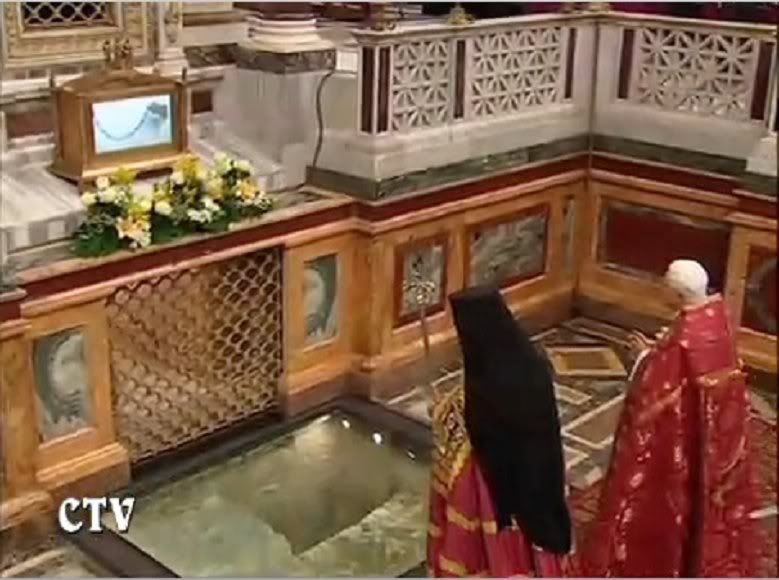 The Pope and the Patriarch pray at the altar that holds the 'chains of St. Paul' and underneath which may be the seen - through a glass panel - the recently unearthed tomb of the Apostle.
The Pope and the Patriarch pray at the altar that holds the 'chains of St. Paul' and underneath which may be the seen - through a glass panel - the recently unearthed tomb of the Apostle.
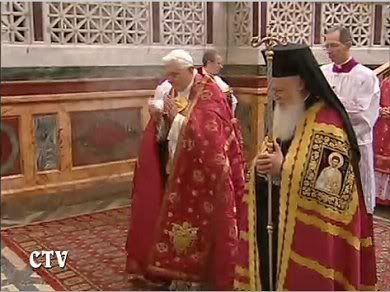 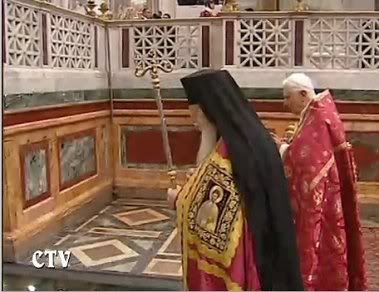
Rome, June 28 (AsiaNews) - "Bring us back together again, from all our divisions": Benedict XVI's prayer for Christian unity marked today's opening of the Pauline Year, which celebrates the 2000th anniversary of the birth of the Apostle to the Gentiles.
The desire for unity was also expressed in the few words spoken by Ecumenical Patriarch Bartholomew, after the Pope. With them, as a concrete image of the journey of ecumenism, was a representative of the archbishop of Canterbury, who was unable to attend the ceremony, and of other Christian churches and communities, and patriarchs representing the Eastern Churches, including Russia.
Before entering the Basilica of St Paul's Outside the Walls, the Pope and the representatives of other Churches, walked in procession around the four-sided portico of the basilica.
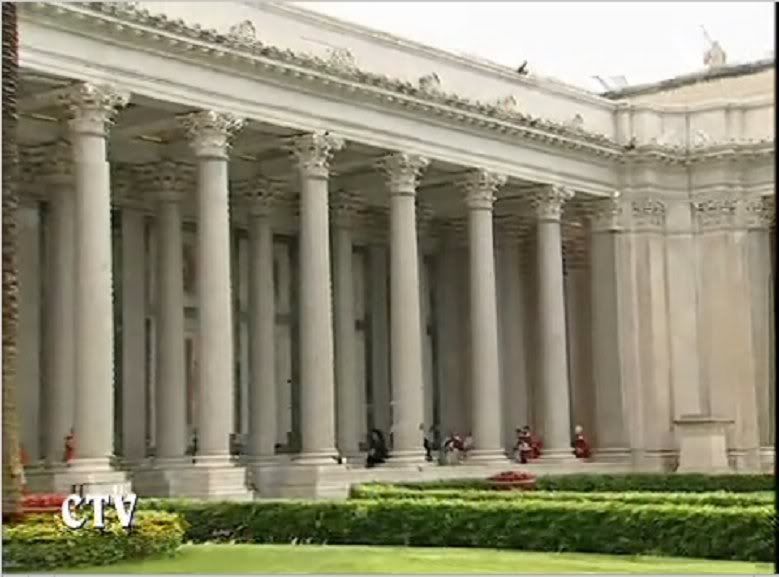
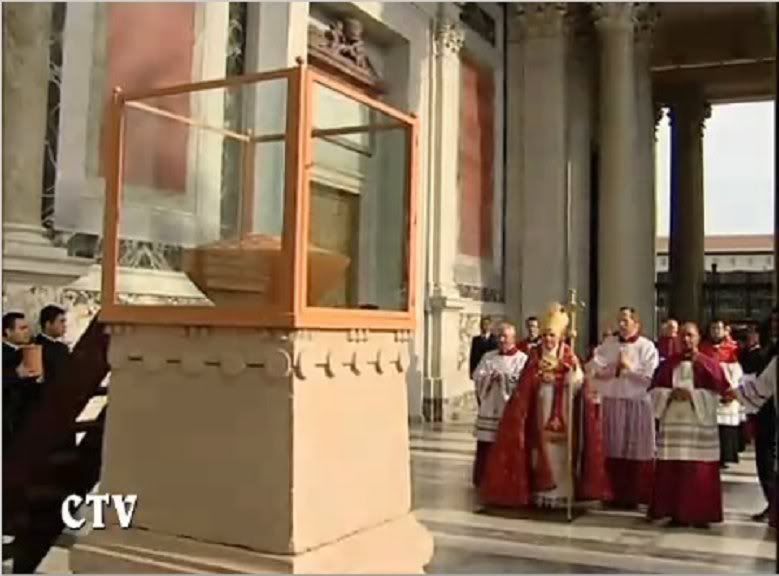
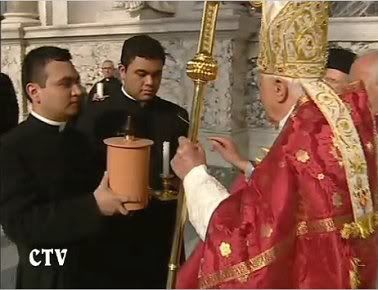 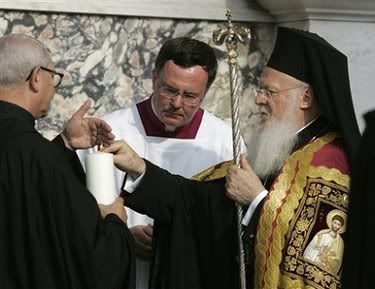
Next to the Pauline Door, Benedict XVI lit the first candle of the brazier that will remain lit for the entire Pauline Year, until June 29, 2009. After him, the gesture was repeated by the ecumenical patriarch and the representatives of the other Churches.
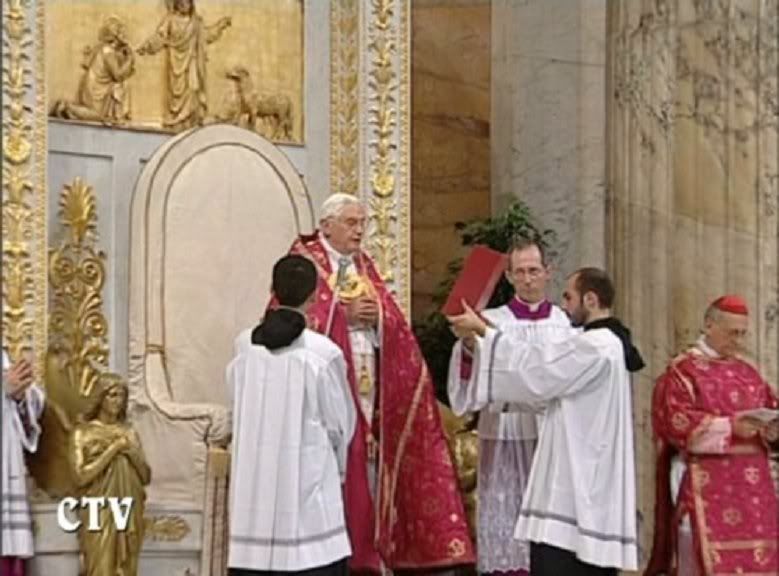
"Who is Paul?" began Benedict XVI's homily tonight. "Teacher of the gentiles, apostle and proclaimer of Jesus Christ", the Pope recalled, "is how he characterises himself in a retrospective look at the course of his life. But with this, our attention is not directed only to the past. 'Teacher of the gentiles' - this title is open to the future, to all peoples and all generations. Paul is not for us [only] a figure of the past, whom we recall with veneration. He is also a teacher, apostle and proclaimer of Jesus Christ for us as well. We have therefore gathered not to reflect on a history left behind forever. Paul wants to speak with us - today".
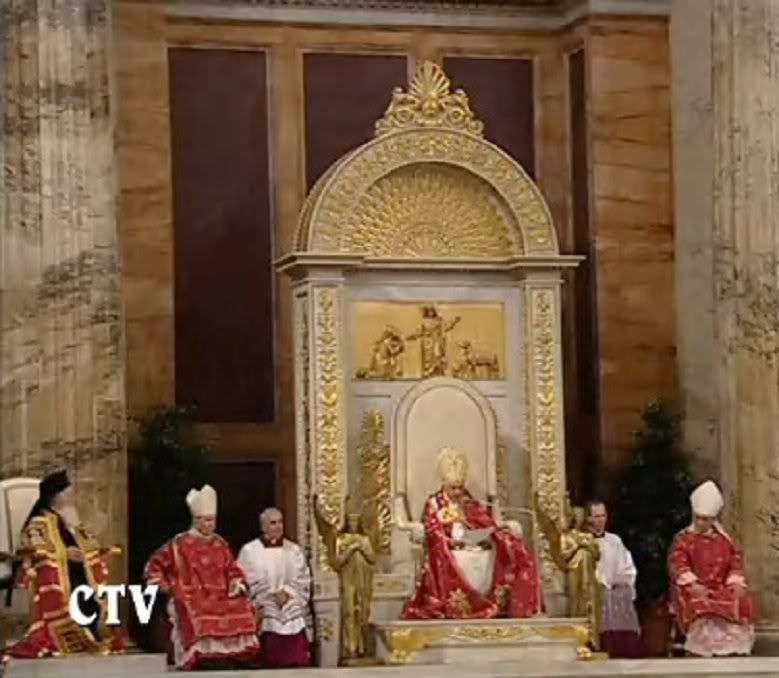
"In the letter to the Galatians", he continued, "he provided for us a very personal profession of faith, in which he opens his heart to the reader of all times, and reveals the deep driving force of his life. 'I live by faith in the Son of God who has loved me and given himself up for me' (Gal. 2:20)."
"Everything that Paul does begins from this centre. His faith is the experience of being loved by Jesus Christ in a completely personal way; it is the awareness of the fact that Christ has faced death not for some anonymous person, but out of love for him - for Paul - and that, as the Risen One, he still loves him. Christ has given himself for him.
"His faith comes from being transfixed by the love of Jesus Christ, a love that shakes him to his core and transforms him. His faith is not a theory, an opinion about God and the world. His faith is the impact of the love of God on his heart. And thus his faith is itself love for Jesus Christ.
"This love is now the 'law' of his life, and in this very way it is the freedom of his life. He speaks and acts on the basis of the responsibility of love. Freedom and responsibility are here united in an inseparable way. Because he stands in the responsibility of love, he is free; because he is someone who loves, he lives completely in the responsibility of this love and does not take freedom as the pretext for willfulness and egoism".
In the "search for the interior physiognomy of St Paul", Benedict XVI evoked the words that Jesus spoke to him on the road to Damascus, "Saul, Saul, why do you persecute me?", in order to highlight how in these words there is an "identification" between Christ and his Church.
Benedict said "It is the Lord himself, then, who asks: "How could you have lacerated my body? Before the face of Christ, this word becomes at the same time an urgent request: Bring us back together again, from all our divisions. Make this a reality again today: there is only one bread, because we, although we are many, are only one body".
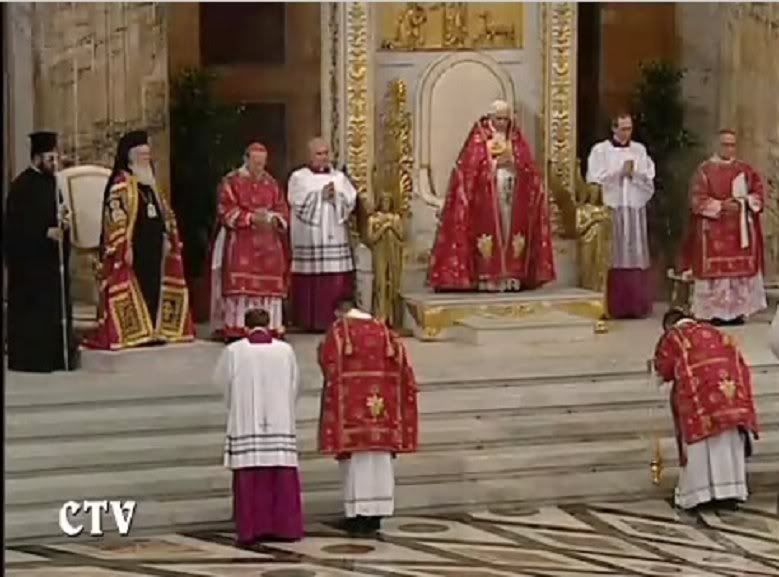
"We hope that the life and Letters of St Paul", echoed Patriarch Bartholomew in his homily, "may continue to be for us a source of inspiration 'so that all nations may be obedient to faith in Christ' (cf. Rom. 16:27)".
"The radical conversion and apostolic kerygma of Saul of Tarsus", he said earlier, "'shook' history in the literal sense of the term, and moulded the very identity of Christianity".
Referring to the Basilica, Bartholomew said: "This sacred place outside the Walls is without a doubt eminently suited for commemorating and celebrating a man who established a marriage between the Greek language and the Roman mentality of his time, stripping Christianity, once and for all, from any mental restriction, and establishing forever the catholic foundation of the ecumenical Church".
In conjunction with the celebrations of the Catholic Church, the Pauline Year was inaugurated today in Damascus as well - this city of the apostle's conversion - with the participation of all the Christian communities: Catholic, Orthodox, and Protestant.
The inauguration was proclaimed, in the name of all the Christian communities the city, by the Greek Orthodox patriarch of Antioch, Ignatius IV, while the Greek-Melkite Catholic patriarch of Antioch, Gregory III, was in Rome at the basilica of St Paul.
In Turkey, the modern-day location of Tarsus, the city of St Paul's birth, the Year was opened a few days in advance, on the 22nd. In Tarsus, as of today, there are officially no Christians or churches. For this year, permission has been requested for the use of the old church of St Paul, officially a museum, as well as many other churches in Turkey. [Modificato da TERESA BENEDETTA 29/06/2008 11:52] |
 29/06/2008 14:03 29/06/2008 14:03 |
|
| | | OFFLINE | | Post: 14.107 | Registrato il: 28/08/2005
| Utente Gold | |
|
SOLEMNITY OF SAINTS PETER AND PAUL:
PAPAL MASS AT ST. PETER'S BASILICA
WITH PATRIARCH BARTHOLOMEW I
A full translation of the homilies today by Patriarch Bartholomew I and Pope Benedict XVI
has been posted in HOMILIES, DISCOURSES, MESSAGES, and the translation of the Pope's
Angelus message in AUDIENCE AND ANGELUS TEXTS.
A description of today's liturgy from the Vatican:
At the Vatican Basilica, starting at 9:30 today, the Solemnity of Saints Peter and Paul, the Hooly Father Benedict XVI celebrated the Eucharist with the participation of Ecumenical Patriarch Bartholomew I.
Concelebrating with the Holy Father were the new Metropolitan Archbishops, on whom the Pontiff would impose the sacred pallium of office.
The Ecumenical Patriarch was welcomed by the Holy Father at the front steps of St. Peter's Basilica. They entered St. Peter's together.
After donning liturgical garments, they processed towards the Altar, preceded by the Orthodox Deacon adn the Latin Deacon, each carrying the Gospel.
During the Mass, after the reading of the Gospel proclaimed in Latin and in Greek, the Holy Father presented the Ecumenical Patriarch to the Assembly. The Patriarch and then the Holy Father each delvivered a homily.
Together, the Pope and the Patriarchthen recited the profession of faith - the Nicene Constantinople Creed in the original Greek, according to Byzantine practice.
After the prayer for the faithful, the Holy Father blessed and imposed the pallia - taken from the Confessio altar at the Tomb of St. Peter where they were left overnight - on 40 Metropolitan Archbishops named in the past 12 months:
- Cardinale John Njue, Nairobi (Kenya)
- Mons. Fouad Twal, Patriarch of Jerusalem of the Latins
- Mons. Michel Christian Cartatéguy, Niamey (Niger)
- Mons. Edwin Frederick O’Brien, Baltimore (USA)
- Mons. Francisco Pérez González, Pamplona-Tudela (Spain)
- Mons. Lorenzo Voltolini Esti, Portoviejo (Ecuador)
- Mons. Paolo Pezzi, Mother of God Cathedral, Moscow
- Mons. Tadeusz Kondrusiewicz, Minsk-Mohilev (Belarus)
- Mons. Andrés Stanovnik, Corrientes (Argentina)
- Mons. Anthony Mancini, Halifax (Canada)
- Mons. Martin William Currie, Saint John’s, Newfoundland (Canada)
- Mons. Mauro Aparecido dos Santos, Cascavel (Brazil)
- Mons. Giancarlo Maria Bregantini, Campobasso–Boiano (Italy)
- Mons. John Hung Shan-Chuan, Taipei (Taiwan)
- Mons. Matthew Man-Oso Ndagoso, Kaduna (Nigeria)
- Mons. Reinhard Marx, Munich-Freising
- Mons. Óscar Urbina Ortega, Villavicencio (Colombia)
- Mons. Laurent Monsengwo Pasinya, Kinshasa (Democratic Republic of the Congo)
- Mons. Willem Jacobus Eijk, Utrecht (Netherlands)
- Mons. Antonio José López Castello, Barquisimeto (Venezuela)
- Mons. Richard Anthony Burke, Benin City (Nigeria)
- Mons. Agustin Roberto Radrizzani, Mercedes-Uján (Argentina)
- Mons. José Francisco Sanches Alves, Évora (Portugal)
- Mons. Ján Babjak, Prešov of the Catholics of the Byzantine Rite (Slovakia)
- Mons. Giovanni Paolo Benotto, Pisa (Italy)
- Mons. Stanislav Zvolenský, Bratislava (Slovakia)
- Mons. Robert Rivas, Castries (Saint Lucia)
- Mons. Francesco Montenegro, Agrigento (Italy)
- Mons. Louis Kébreau, Cap Haïtien (Haïti)
- Mons. Joseph Serge Miot, Port au Prince (Haïti)
- Mons. Laurent Ulrich, Lille (France)
- Mons. John Ribat, Port Moresby (Papua New Guinea)
- Mons. Thomas Kwaku Mensah, Kumasi (Ghana)
- Mons. Thomas John Rodi, Mobile, Alabama (USA)
- Mons. Donald James Reece, Kingston (Jamaica)
- Mons. Sławoj Leszek Głodz, Gdańsk (Poland)
- Mons. Peter J. Kairo, Nyeri (Kenya)
- Mons. John Clayton Nienstedt, Saint Paul-Minneapolis
- Mons. John Lee Hiong Fun-Yit Yaw, Kota Kinabalu (Malaysia)
- Mons. Luís Gonzaga Silva Pepeu, Vitória da Conquista (Brazil), and
- Mons. Marin Srakić, Djakovo-Osijek (Croatia).
Two Archbishops (Mons. William d'Souza of Patna, India, and Mons. Edward Tamba Charles of Freetown, Sierra Leone) who were unable to come to Rome, will receive their pallium from the Apostolic Nuncio in their respective diocesan seats.
At the end of the Eucharistic celebration, the Pope and the Patriarch will deliver the final blessing to teh assembly.
Yahoo has just started posting newsphotos of the Mass, two hours after it ended, but Caterina in the main forum outdid herself today with posting prompt montages of her videocaps in the main forum, and shown here.
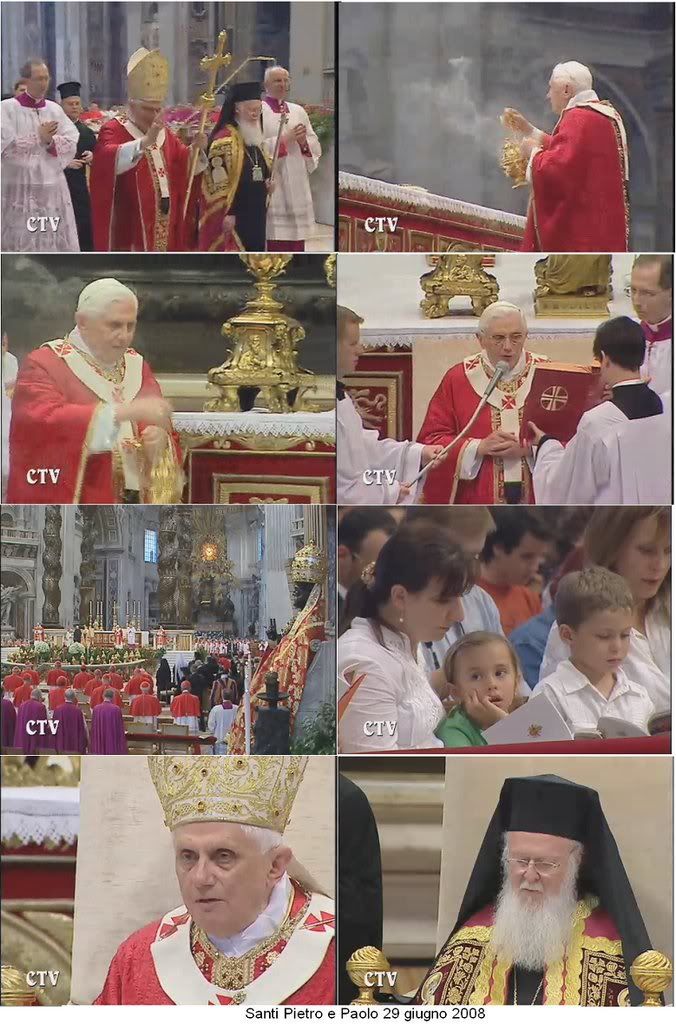

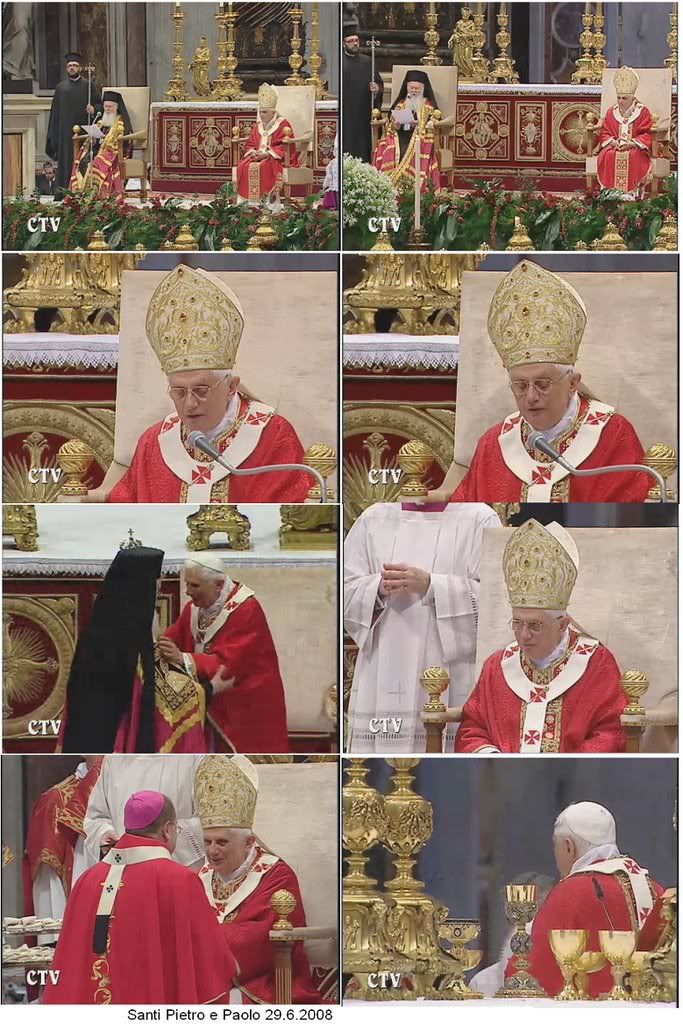

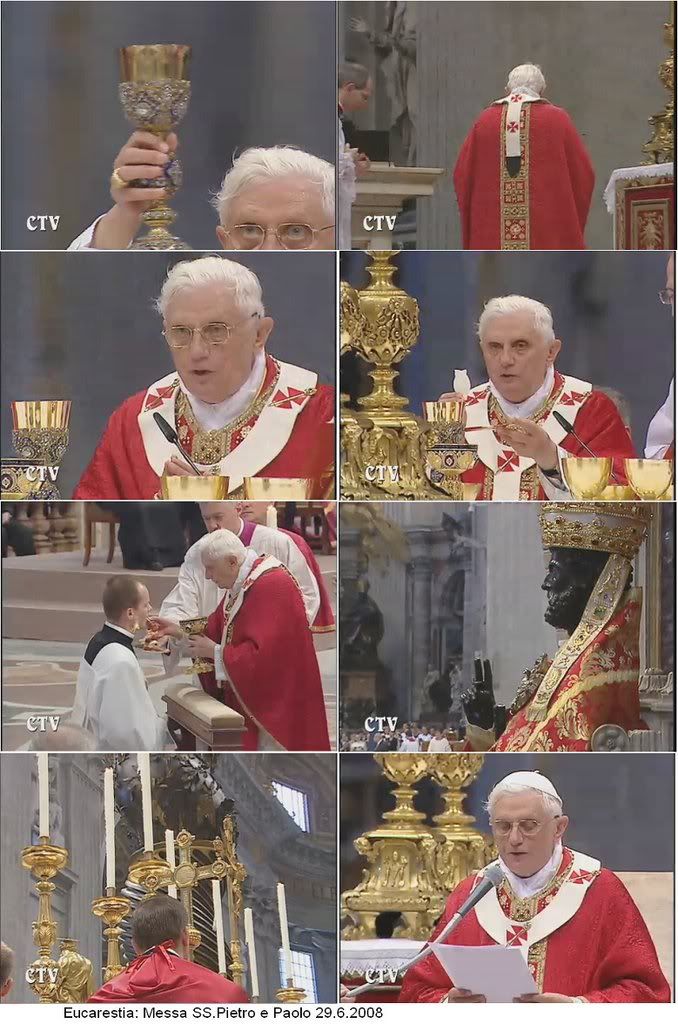
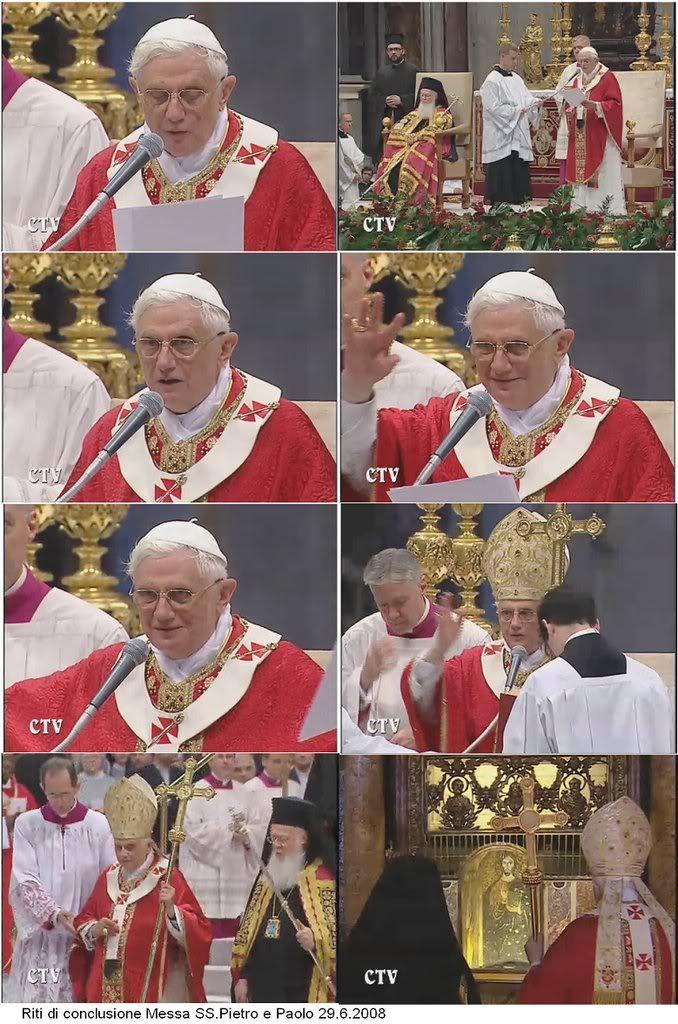
The Pope wore a re-styled pallium for the first time today. During the Mass, he imposed the pallium on 40 metropolitan archbishops froma r9und the world who were named to their posts in the past 12 months.
Since the Mass ended around noon, the Holy Father delivered his Angelus message and led the Angelus prayers before he and the Patriarch imparted the final blessing.
After the Mass, they descended to the Confessio to pray before the tomb of St. Peter (last frame of the last montage).
=====================================================================
ANNIVERSARY FOR THE RATZINGER BROTHERS
Not to forget that every June 29th is also a special day for Joseph and Georg Ratzinger, who were ordained to tthe priesthood in Freising Cathedral on June 29, 1951, by Cardinal Michael Faulhaber of Munich.
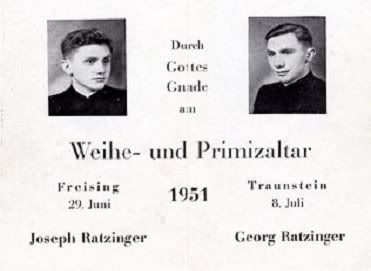 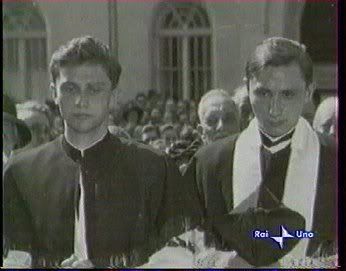
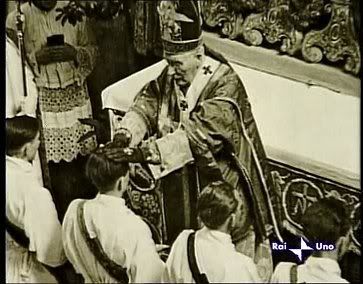 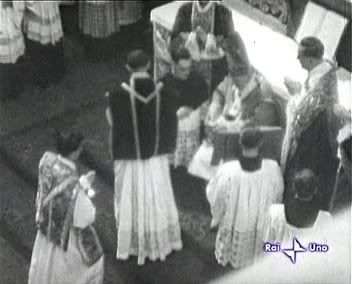
[Modificato da TERESA BENEDETTA 01/07/2008 01:09] |
 29/06/2008 15:11 29/06/2008 15:11 |
|
| | | OFFLINE | | Post: 14.108 | Registrato il: 28/08/2005
| Utente Gold | |
|
SOLEMNITY OF SAINTS PETER AND PAUL:
PAPAL MASS AT ST. PETER'S BASILICA
WITH PATRIARCH BARTHOLOMEW I (2)
A full translation of the homilies today by Patriarch Bartholomew I and Pope Benedict XVI has been posted in HOMILIES, DISCOURSES, MESSAGES, and the translation of the Pope's Angelus message in AUDIENCE AND ANGELUS TEXTS.
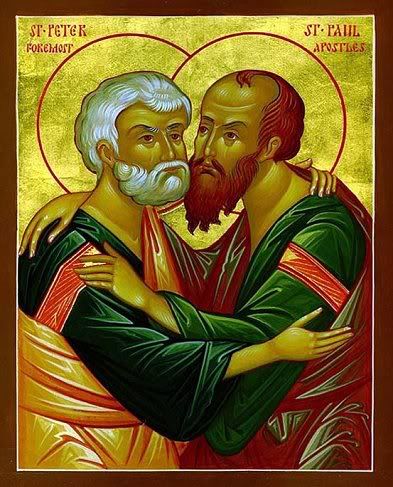 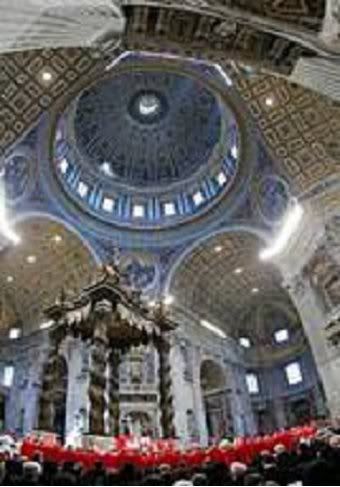
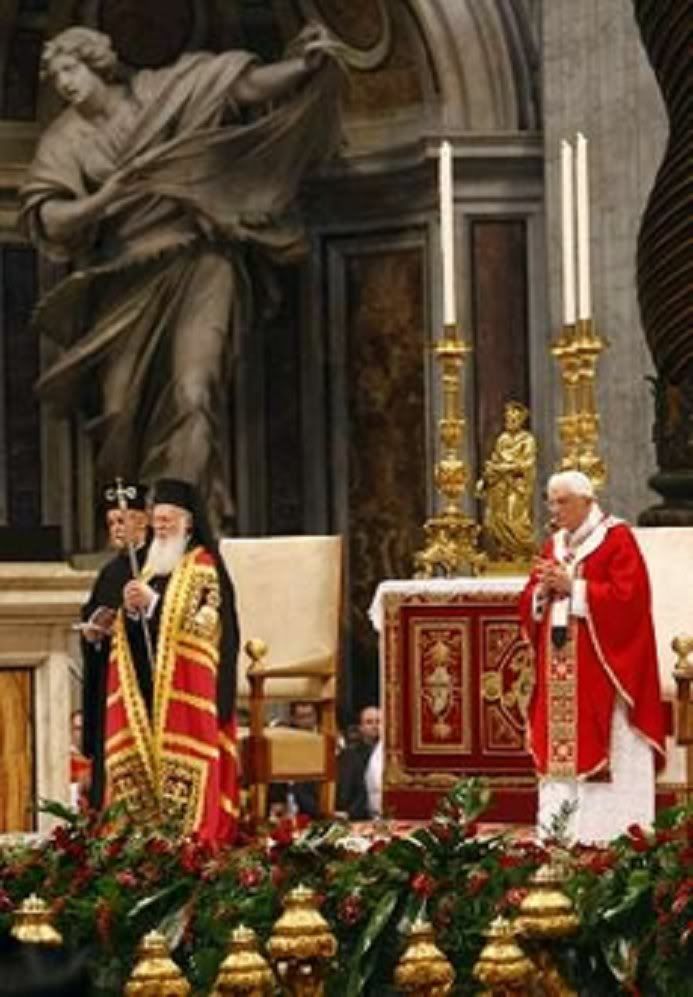 Pope Benedict speaks of Christian unity
Pope Benedict speaks of Christian unity
and mission to all peoples
on the Feast of Peter and Paul

Vatican City, June 29 (AsiaNews) - Side by side with the ecumenical patriarch of Constantinople, Bartholomew I, in the presence of 40 Catholic metropolitan archbishops to whom he gave the pallium, Benedict XVI today celebrated the liturgy of the solemnity of Saints Peter and Paul in the Vatican basilica.
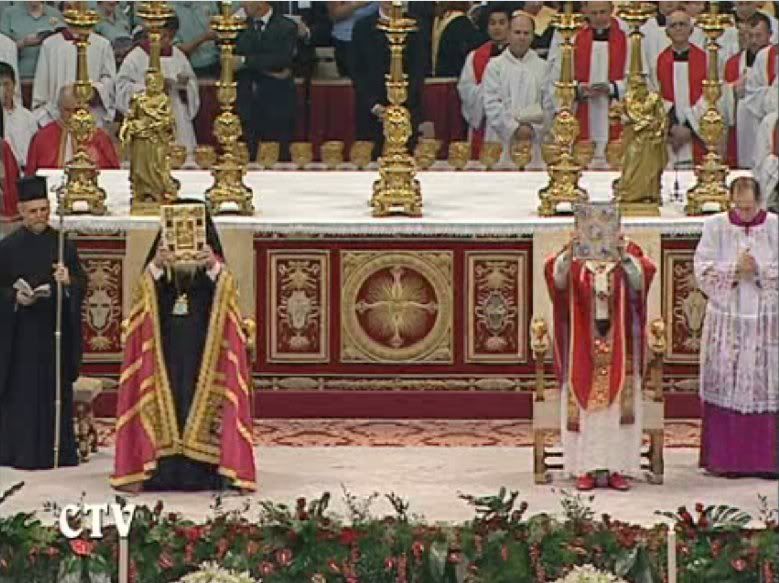
A liturgy rich in symbols: the Greek Orthodox Patriarch sat beside the Catholic Pontiff on the altar; the Gospels were proclaimed by two deacons, Greek Orthodox and Latin, who brought the book of the Gospels to be kissed by the pastor of the other confession; the Creed proclaimed together in the Greek formula of the Nicene Council; the fraternal exchange of peace between the Pontiff and the Patriarch.
Unity and collegiality, "romanità" and universality, ecumenism and mission were woven together in the words of Bartholomew I and in those of the Pope, while the assembly applauded both.
No risk of ritualism or of abstract theology: All of the emphases, the search for theological and pastoral unity, the symbol of the pallium, the very commemoration of the martyred apostles are a function of the mission to the world, for "peace" - as Bartholomew I said - or in order to bring about, as the Pope said, "a new kind of city that must be formed continually anew in the midst of the old human city, which remains under threat from the opposing forces of sin and human egoism".
After the proclamation of the Gospel, Benedict XVI introduced the address by Bartholomew I, who emphasised the profound unity and friendship that binds Constantinople ("the new Rome") and the "old Rome".
He affirmed that theological dialogue "continues forward, beyond the considerable difficulties that remain and the well-known problems", and expressed his hope that soon, "as soon as possible", full unity may be reached.
The visit of the delegation from the patriarchate to Rome for the feast of the holy apostles - which has become a tradition - is itself an expression of this desire, and of a form of unity already present.
This year, Bartholomew I himself wanted to be present in order to repay the Pope's visit to Constantinople in November 2006, but above all, to inaugurate together the Pauline Year marking the 2000th anniversary of the birth of Saint Paul.
Bartholomew I said that for the Orthodox Church as well, this is "the Year of the apostle Paul", in which the Church of the East has planned pilgrimages to Rome and to the places of the apostle's activity in Turkey (Ephesus, Miletus, etc.) and to Greece, Rhodes, and Crete.
In his homily, the Pontiff emphasised the value of Rome as the place of martyrdom of the two apostles: "Through their martyrdom, they became brothers; together they were the founders of the new Christian Rome".
And he added: "The blood of the martyrs does not call for vengeance, but rather reconciles. It does not present itself as an accusation, but as 'luce aurea' . . . as the power of love that overcomes hatred and violence, thus founding a new city, a new community. Because of their martyrdom, they - Peter and Paul - are now part of Rome: through martyrdom, Peter as well became a Roman citizen forever. Through martyrdom, through their faith and love, the two apostles show where real hope lies, and are the founders of a new kind of city that must be formed continually anew in the midst of the old human city, which remains under threat from the opposing forces of sin and human egoism".
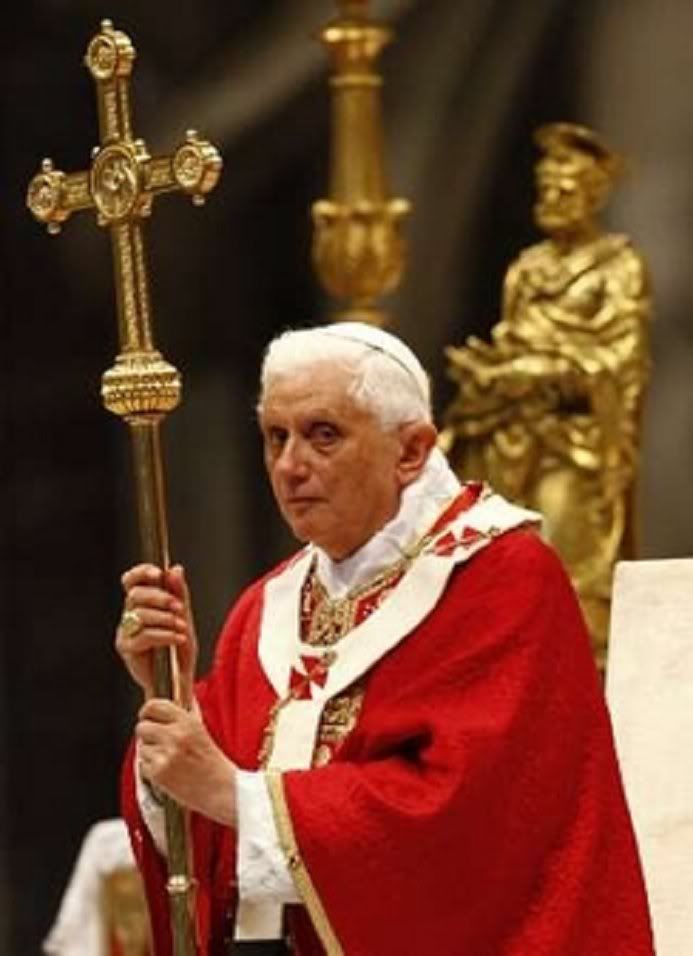
Benedict XVI asked "why" Peter and Paul came to Rome. "[For Paul,] going to Rome was part of the universality of his mission to all peoples. The road to Rome . . . was an integral part of his task of bringing in the Gospel to all the gentiles - of founding the catholic, universal, Church. Going to Rome was for him an expression of the catholicity of his mission. Rome must make the faith visible to all the world, it must be the place of encounter in the one faith".
For his part, the Pope continued, Peter is the one who opened the doors of the pagans to the Christian faith (see the episode with the centurion Cornelius, Acts 10).
"Peter", the Pope explained, ". . . left the leadership of the Christian-Jewish Church to James the Less, in order to dedicate himself to his true mission: to his ministry for the unity of the one Church of God formed from Jews and pagans. St Paul's desire to go to Rome emphasises - as we have seen - among the characteristics of the Church, above all the word 'catholic'. St Peter's journey to Rome, as representative of the peoples of the world, falls above all under the word 'one': his task was that of creating the unity of the catholica, of the Church made up of Jews and pagans, of the Church of all peoples. "
"And this is the permanent mission of Peter: to make it so that the Church never be identified with a single nation, with a single culture or a single state. That it always be the Church of all. That it unite humanity beyond all boundaries, and, in the midst of the divisions of this world, make present the peace of God, the reconciling power of his love".
The unity of the Church, guaranteed by the ministry of Peter and of his successors, is not an end in itself, but a necessity for the world, which is always divided: "Thanks to the uniformity of technology, thanks to the worldwide network of information, thanks also to the connection of common interests, there now exist in the world today new ways of unity, which are however leading to an explosion of new disagreements, and giving a new impetus to old ones.
"In the midst of this external unity, based on material things, we need interior unity all the more, which comes from the peace of God - the unity of all those who through Jesus Christ have become brothers and sisters. This is the permanent mission of Peter, and also the particular task entrusted to the Church of Rome".
The last part of the homily was dedicated to the 40 archbishops who received the pallium from him today, a collar made of lamb's wool, embroidered with five crosses (a symbol of the five wounds of Christ).
Among the archbishops from all over the world, those from Asian dioceses were: Archbishop Fouad Twal, Latin patriarch of Jerusalem; John Hung Shan-Chuan of Taipei (Taiwan); John Lee Hiong Fun-Yityaw, of Kota Kinabalu (Malaysia); and Archbishop Paolo Pezzi, from Moscow. The archbishop of Patna, William D'Souza, will instead receive the pallium in his see.
"When we take the pallium upon our shoulders", the Pope explained, "this gesture reminds us of the Shepherd who takes upon his shoulders the lost sheep, which on its own was not able to find the way home, and brings it back to the fold". But Jesus Christ "also wants men who will 'carry' together with Him" lost humanity.
"The pallium", he added, "becomes a symbol of our love for the Shepherd, Christ, and of our loving together with Him - it becomes a symbol of the call to love men as He does, together with Him: those who are searching, those who are questioning, those who are sure of themselves and those who are humble, the simple and the great; it becomes a symbol of the call to love all with the power of Christ and in view of Christ, so that they may find Him, and in Him, themselves".
The pallium, he added finally, is a sign of collegiality, of unity among all the bishops and with the pope: "No one is a Shepherd on his own. We are successors to the Apostles thanks only to being in collegial communion, in which the college of the Apostles finds its continuation. Communion, the 'we' of the Shepherds, is part of being Shepherds, because the flock is only one, the one Church of Jesus Christ And finally, this 'with' also refers to communion with Peter and with his successor as the guarantee of unity".
Before the conclusion, Benedict XVI led the recitaiton of the Angelus, and in his reflection before the Marian prayer he again emphasised the value of the Pauline Year, which will last until June 29, 2009.
"This special jubilee", the Pope said, "will naturally have Rome as its centre of gravity, and in particular the basilica of St Paul outside the Walls, and the place of martyrdom, at Tre Fontane.
"But it will involve the entire Church, beginning from Tarsus, Paul's birthplace, and from the other Pauline locations that will be the destinations for pilgrimages in modern-day Turkey, as also in the Holy Land, and the island of Malta, where the apostle landed after a shipwreck and sowed the fertile seed of the Gospel. In reality, the horizon of the Pauline Year can be nothing but universal".
Paul, in fact, was "the apostle of those far off".
"In a world that has become 'smaller'", he added, "but in which many still have not encountered the Lord Jesus, the jubilee of St Paul invites all Christians to be missionaries of the Gospel".
"This dimension of mission", he continued, "must always be accompanied by that of unity, represented by Saint Peter, the 'rock' on which Jesus Christ built his Church. As the liturgy emphasizes, the charisms of the two great apostles are complementary for the edification of the one People of God, and Christians cannot give valid witness to Christ if they are not unified among themselves".
At the end of the celebration, to emphasize further the great harmony with the Eastern Church, the Pope and the patriarch of Constantinople blessed the faithful together. They then went to the tomb of Saint Peter, beneath the altar of confession, for a shared moment of silent prayer.
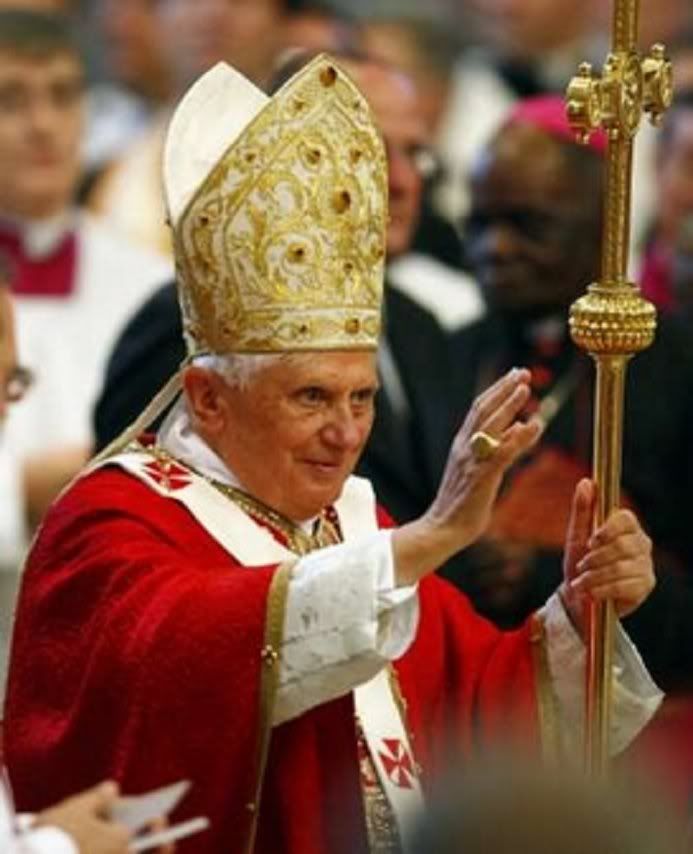
=====================================================================
P.S. I watched EWTN's coverage of the Mass twice - on direct broadcast and on replay - and I can't get over my awe at the stupendous reading of the Creed together - in perfect unison of phrasing between the Pope and the Patriarch. Even if I do not know Greek, one felt the power of that joint profession of faith that one could join mentally since the articles of the Christian Creed are known to each of us....
And then, there's Pope Benedict's homily! What a fresh and refrehsing juxtaposition of Peter and Paul, and a particularly moving restatement of the primary mission of Peter and his successors! I was thankful I had already done a full translation by the time I watched the replay, because I continue to be relentlessly intolerant of any commentator translating over and drowning the Holy Father's delivery.
[Modificato da TERESA BENEDETTA 30/06/2008 19:59] |
 29/06/2008 17:19 29/06/2008 17:19 |
|
| | | OFFLINE | | Post: 14.109 | Registrato il: 28/08/2005
| Utente Gold | |
|
SOLEMNITY OF SAINTS PETER AND PAUL:
PAPAL MASS AT ST. PETER'S BASILICA
WITH PATRIARCH BARTHOLOMEW I (3)
A full translation of the homilies today by Patriarch Bartholomew I and Pope Benedict XVI
has been posted in HOMILIES, DISCOURSES, MESSAGES, and the translation of the Pope's
Angelus message in AUDIENCE AND ANGELUS TEXTS.
Gregor Kollmorgen at New Liturgical Movement has video-caps that give a more complete
sense of the liturgy today at St. Peter's. I have selected some of them.
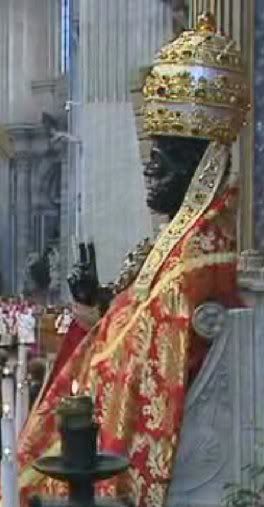 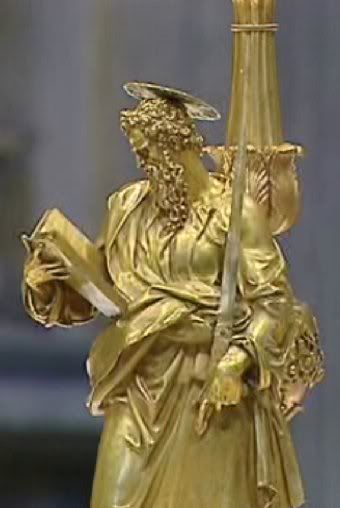 The two Apostles honored today - St. Peter's famous 'touchstone' statue is robed and crowned for the occasion;
The two Apostles honored today - St. Peter's famous 'touchstone' statue is robed and crowned for the occasion;
and St. Paul's bronze statue.
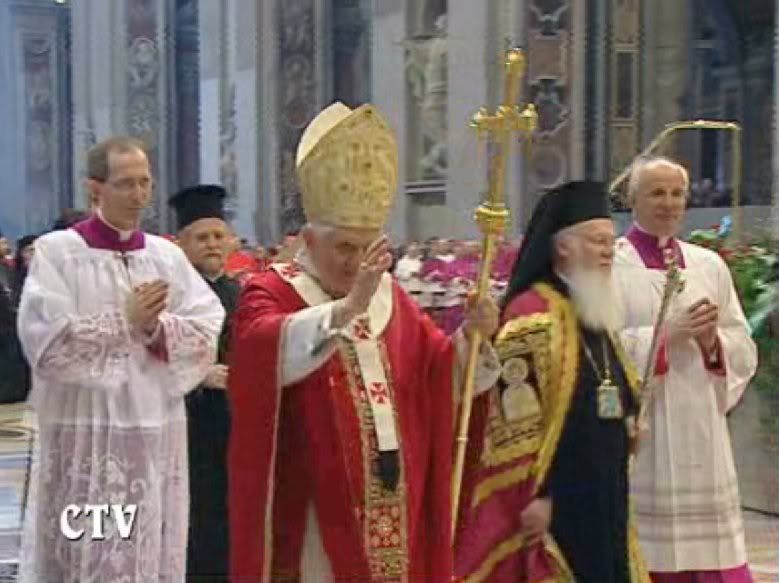
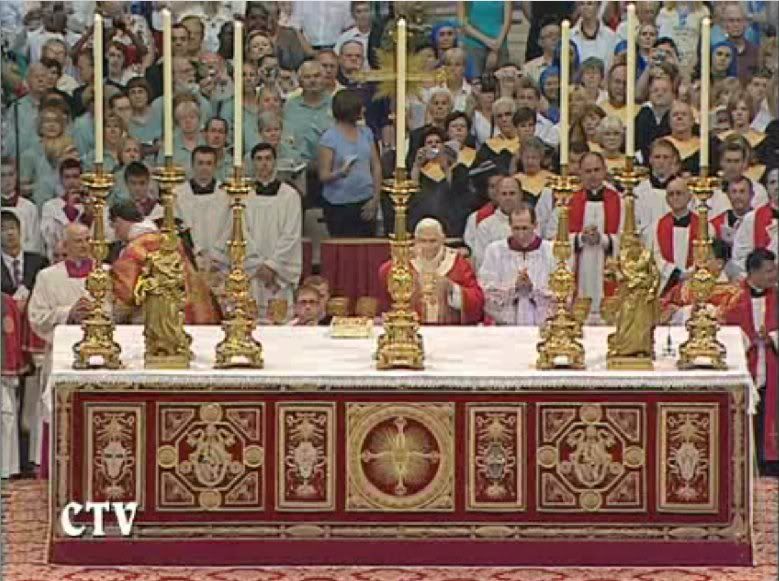
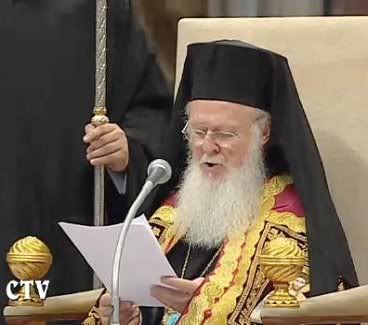 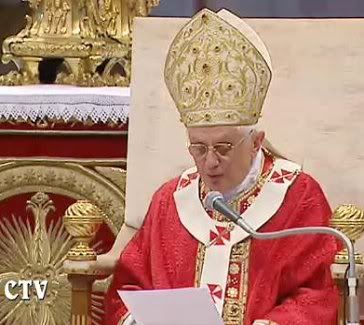 The Patriarch and the Pope each delivered a homily.
The Patriarch and the Pope each delivered a homily.
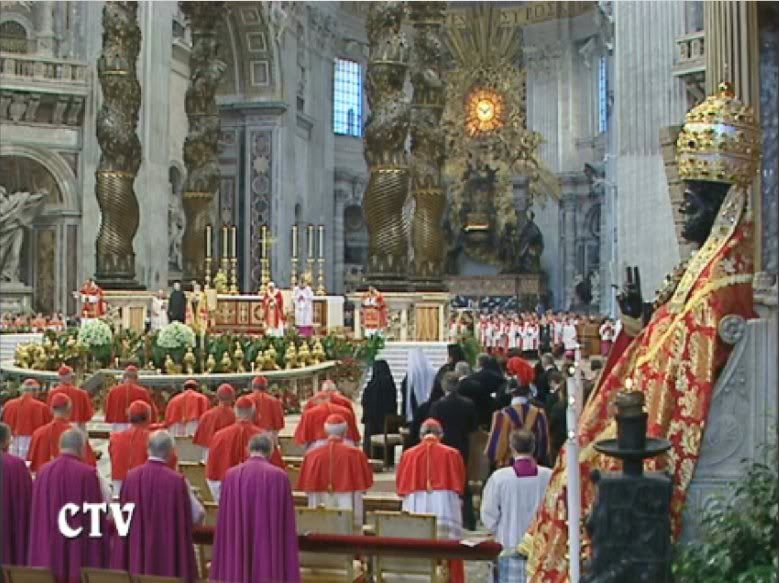
The imposition of the pallium:
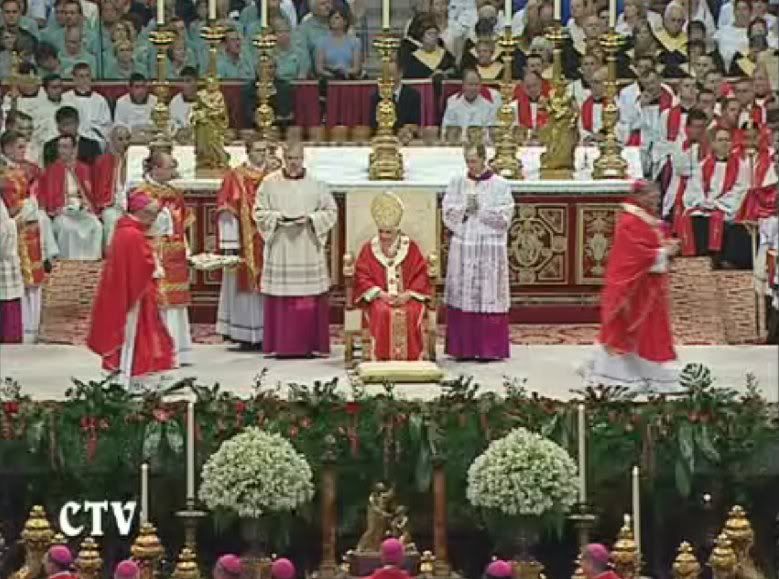
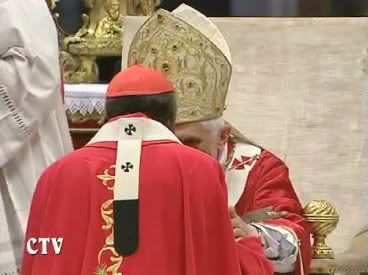 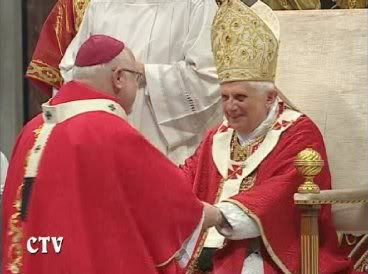 Left photo, Cardinal Njue, Archbishop of Nairobi, was the only cardinal in the group of new metropolitans.
Left photo, Cardinal Njue, Archbishop of Nairobi, was the only cardinal in the group of new metropolitans.
Right photo, Cardinal Reinhold Marx, Archbishop of Munich-Freising.
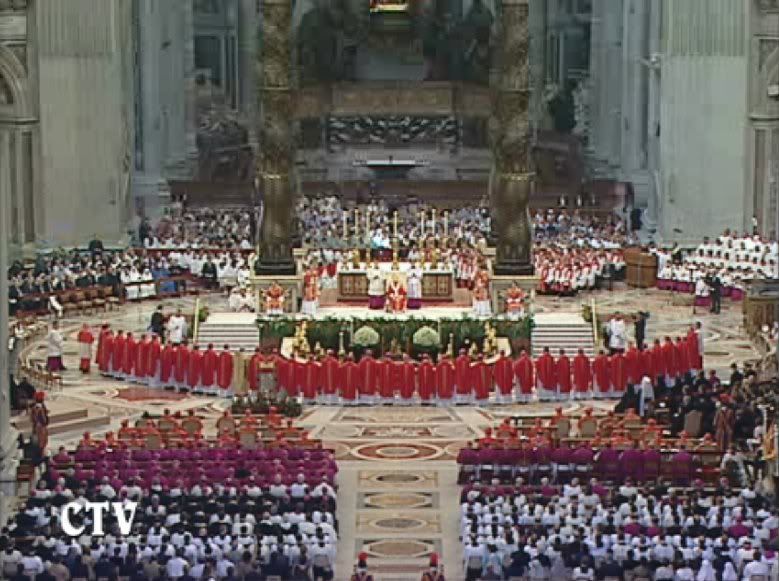 The 40 new metropolitans pledge their loyalty to the Successor of Peter. Father Z has posted the text of the pledge:
The 40 new metropolitans pledge their loyalty to the Successor of Peter. Father Z has posted the text of the pledge:
Ego... Archiepiscopus [PLACE and NAME]
beato Petro apostolo,
Sanctae Romanae Ecclesiae,
ac tibi, Summo Pontifici,
tuisque legitimis Successoribus
semper fidelis ero et oboediens.
Ita me Deus omnipotens adiuvet.
I… Archbishop of the _ diocese
will always be faithful and obedient
to St. Peter the apostle,
the Holy Roman Church,
and to you, the Supreme Pontiff
and to your legitimate Successors.
So help me God Almighty .
[So why is it that some bishops forget they ever pledged loyalty and obedience to the Pope?]
 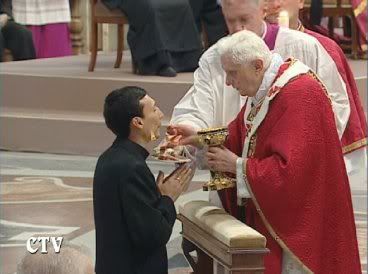 Communion on the tongue, kneeling, has always been the norm since the Host began to be used, but somehow, post-Vatican-II
Communion on the tongue, kneeling, has always been the norm since the Host began to be used, but somehow, post-Vatican-II
reformists made us all believe it had been replaced by receiving the Host in the hand, while standing (not wrong,
but it is an indult - a concession that was allowed - to the norm, Mons. Guido Marini has pointed out). As part of his gradual
'reform of the reform', the Holy Father is setting the example in favor of the norm, which is more reverent and correct.
A full translation of the homilies today by Patriarch Bartholomew I and Pope Benedict XVI
has been posted in HOMILIES, DISCOURSES, MESSAGES, and the translation of the Pope's
Angelus message in AUDIENCE AND ANGELUS TEXTS.
[Modificato da TERESA BENEDETTA 30/06/2008 21:00] |
 29/06/2008 23:51 29/06/2008 23:51 |
|
| | | OFFLINE | | Post: 14.112 | Registrato il: 28/08/2005
| Utente Gold | |
|
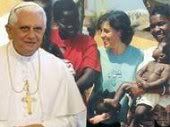 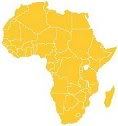 Pope may make first trip
Pope may make first trip
to Africa next year
This story boosts a June 21 report report by Apcom which I translated and posted on Page 192 of this thread. Sorry I haven't had a chance to check out today's Avvenire myself.
VATICAN CITY, June 29 (Reuters) - Pope Benedict may travel to Africa next year for the first time as Pontiff, a senior Vatican official said in comments published on Sunday.
Vatican Secretary of State Tarcisio Bertone said the decision on which countries the German-born Pope might visit would depend partly on geopolitical and security concerns.
"The Pope's travel agenda for 2009 has not yet been set. But it's true that this hypothesis is being worked on," Bertone told Avvenire, the newspaper of the Italian Bishops Conference.
"The Church in Africa deserves a trip by the Pope, who has already visited or is preparing to visit the other continents."
Benedict's predecessor, John Paul II, travelled widely throughout Africa during his more than 26-year pontificate, including to Tunisia, Morocco, Tanzania, Senegal and Uganda.
Pope Benedict will start the longest visit of his pontificate on July 12 when he leaves for a 10-day trip to Australia. It will be Benedict's 9th trip outside Italy since his election in April 2005.
This was the Apcom report:
Benedict may visit
Africa in 2009
 VATICAN CITY, June 21 (Translated from Apcom) - It has been learned from Vatican sources that the Holy See is arranging for Pope Benedict XVI to visit Africa for the first time as Pope perhaps as early as next year.
VATICAN CITY, June 21 (Translated from Apcom) - It has been learned from Vatican sources that the Holy See is arranging for Pope Benedict XVI to visit Africa for the first time as Pope perhaps as early as next year.
The exact first destination is under study, and the sources say an African trip is unlikely to cover several countries. But they say the place will be chosen depending on where it will be best to re-launch the Christian message on the continent today.
Language will be a factor in a country where English and French survive from colonial times as 'common language' alongside hundreds of local languages and dialects.
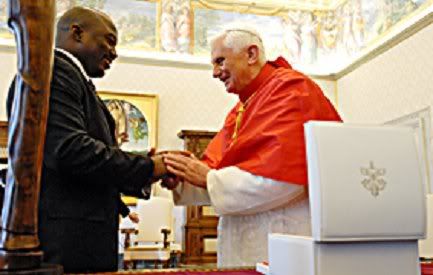  The sources said that, for instance, because of its size and for its being very 'representative' of the continent, the Democratic Republic of the Congo (former Belgian Congo, known as Zaire from 1971-1997), whose President Joseph Kabila, visited the Pope last week and invited him to his country, could well be one of the first destinations.
The sources said that, for instance, because of its size and for its being very 'representative' of the continent, the Democratic Republic of the Congo (former Belgian Congo, known as Zaire from 1971-1997), whose President Joseph Kabila, visited the Pope last week and invited him to his country, could well be one of the first destinations.
In his three years as Pope, Benedict has visited Europe four times,
Asia once (Turkey, whose territory is mostly on the Asian continent) and the Americas. Later this year, he will visiting France.
John Paul II was the first Pope to visit Africa, and he did so several times over the course of his long Pontificate - in 1980, 1982, 1985, twice in 1988, 1989, twice in 1990, twice in 1992, 1993 and 1995.
 |
 30/06/2008 17:00 30/06/2008 17:00 |
|
| | | OFFLINE | | Post: 14.124 | Registrato il: 28/08/2005
| Utente Gold | |
|
  THE POPE'S DAY, 6/30/08
THE POPE'S DAY, 6/30/08
The Holy Father met today with
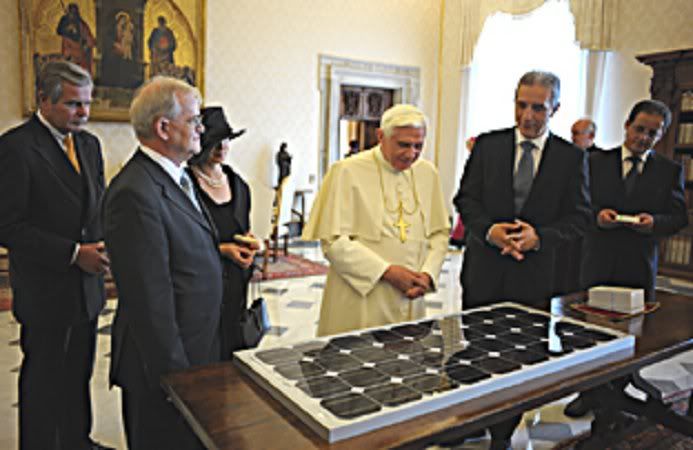
- H.E. Stanislaw Tillich, Minister-President of Saxony (Germany), with his wife and delegation.
- Cardinal Varkey Vithayathil, C.SS.R., Major Archbishop of Ernakulam-Angamaly of the Siro-Malabars (India).
- H.E. Madame Nevine Simaika Halim Abdalla, Ambassador of tehArab Republic of Egypt, on farewell visit.
- Metropolitan Archbishops who received the Pallium yesterday, with their families and friends.
Multilingual address. A full translation has been posted in HOMILIES, DISCOURSES, MESSAGES.
MISSION OF PASTORS
A CONSEQUENCE OF LOVE FOR CHRIST
 
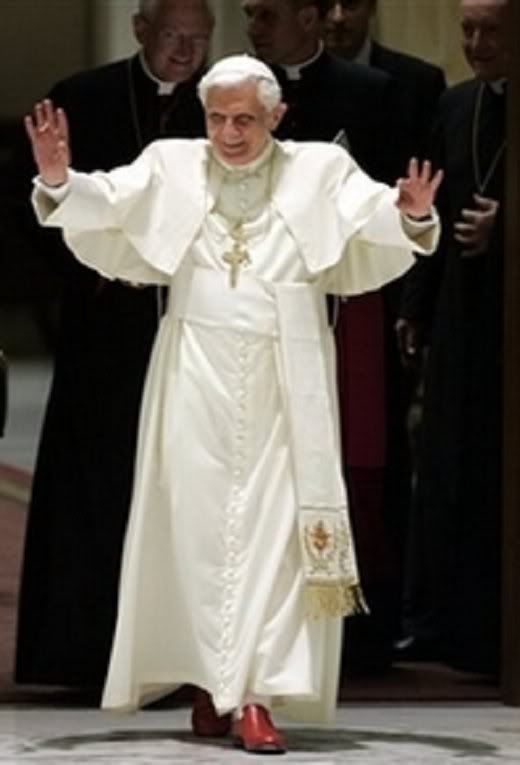
VATICAN CITY, 30 JUN 2008 (VIS) - At midday today, the Pope received 40 metropolitan archbishops accompanied by members of their families.
The archbishops, who were named to their respective dioceses in the past 12 months, yesterday received the pallium from the Pope yesterday during the Eucharistic celebration for the Solemnity of Saints Peter and Paul at the Vatican basilica.
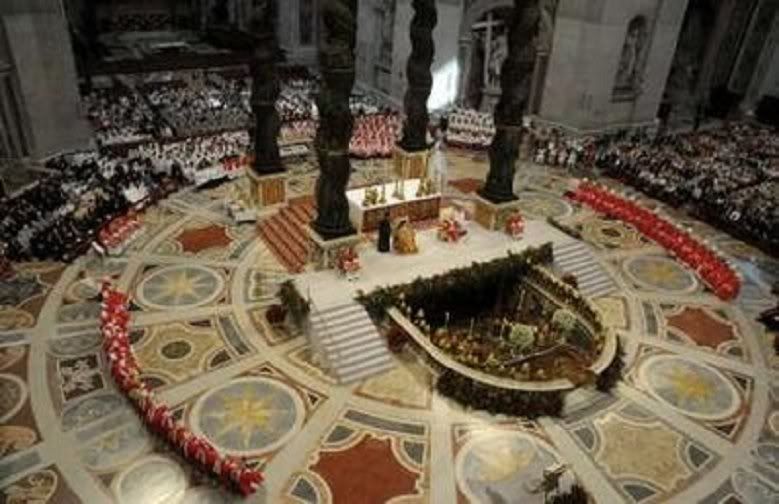
The Holy Father greeted each of the metropolitan archbishops in their respective languages. Then, addressing them as a group, he affirmed that "the image of an organic body applied to the Church is one of the powerful and characteristic elements of the doctrine of St. Paul. In this Jubilee Year dedicated to him, I wish to entrust each of you to his celestial protection. May the Apostle of the Gentiles help each of you to make the communities entrusted to your care grow in unity and mission, in harmonious and co- ordinated pastoral activity, animated by constant apostolic zeal".
"The condition of service for all pastors is love for Christ, which must come before everything", said the Pope.
He then recalled Jesus' question to Peter: "Simon, son of John, do you love me?" saying "may it ever resound in our hearts and stimulate our ever fresh and passionate response: 'Lord, you know everything, you know that I love you'. It is from this love for Christ that the mission to 'feed my sheep' arises, a mission that may be summarised above all in His own testimony: ... 'follow me'".
 The Pope imparts his blessing at the end of the audience today for the archbishops and their families and friends.
The Pope imparts his blessing at the end of the audience today for the archbishops and their families and friends.
.
POPE TO CASTEL GANDOLFO
TILL HE LEAVES FOR SYDNEY


VATICAN CITY, June 30 (Translated from Apcom) - Pope Benedict XVI will move in early to Castel Gandolfo this year to escape the summer heat of Rome.
After the General Audience on Wednesday, the Pope will proceed to the papal summer residence along Lake Alban, where he will stay until he leaves for Australia on July 12.
He will be back in Castle Gandolfo on July 21 before leaving for his regular summer vacation to be spent this time in Bressanone, in the Alto Adige region of northeastern Italy, from July 28 to August 11.
[Modificato da TERESA BENEDETTA 01/07/2008 20:20] |
 30/06/2008 18:22 30/06/2008 18:22 |
|
| | | OFFLINE | | Post: 14.125 | Registrato il: 28/08/2005
| Utente Gold | |
|
   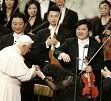 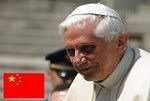 ONE YEAR AGO TODAY -
ONE YEAR AGO TODAY -
BENEDICT XVI'S HISTORIC
LETTER TO CHINESE CATHOLICS
Translated from

VATICAN CITY, June 30 (Fides News Agency) - One year after the publication of the Holy Father's letter to the Catholics of China, it seems impossible to evaluate any outcome so far in terms of listing concrete results.
For a document that is widely considered to be historic, it requires a sufficient time period before one may judge its impact on the life of the Chinese Catholics.
Moreover, the best 'fruits' expected from a Pope's pastoral letter are spiritual in nature and therefore do not lend themselves to the usual reportage.
The publication of the letter was greeted by an initial burst of enthusiasm and of gratitude to the Holy Father, but not without apprehension especially at the political level.
The letter was welcomed for being clear, balanced, affectionate, paternal, etc. Now, the interest is to examine the pontifical message closer - What is the Pope asking of the Chinese Catholics, and of the universal Church with respect to the Catholics of China?
The first message that everyone seemed to get right away was that 'things are different, we cannot go on as before'. The Pope indicated a radical change of attitude that must be taken not only within the Catholic community in China (still split between an underground Church and the 'official' one) but also in relation to the government of China itself and the role of Catholics as citizens.
After the Holy Father's clear affirmation that there is only one Church in China - and that the internal split is the result of external pressures - Chinese Catholics are starting to consider each other as 'brothers together'.
The Church in China is one because now almost all the bishops are in full communion with Rome, even if the internal structure remains anomalous. The unity is far from concretely realized but the direction indicated by Benedict XVI is clear to all.
It would be too long to list the small steps that have been happening at various levels that have been reported to us which indicate that a movement towards reconciliation and full unity is gaining ground.
The Pope's letter clearly had an effect on relations between 'underground' and 'official' Catholics, even in places where the divergence was strongest.
One can cite, in general, the increasing participation, often in significant numbers, in each other's liturgies; catechism lessons for 'underground' Catholics entrusted to 'official' Catholics; spiritual retreats undertaken together; and joint study sessions, generally undertaken in 'a climate of prayer', to discuss the Holy Father's letter and how best to act on it.
Funerals and birthdays within parishes have become occasions for reconciliation. Underground Chinese have gone to Confession and attended Mass in 'official' Churches.
Regular contacts between bishops and priests belonging to the 'two' communities have taken place on matters like planning joint celebrations of Catholic feast days like Easter. Priests or nuns of one group lead spiritual retreats for the other.
None of these initiatives ever took place before the Pope's letter.
More important, there are no longer accusations that sacraments administered by one side are not valid for the other. Prayer groups with members from both sides have become popular. In some dioceses, reconciliation has become the basis for pastoral work.
Of course, there still remain isolated instances of resistance to the Pope's recommendations, and requests for clarification on several points continue to be received by the Vatican.
Still, it is quite clear that the Pope's letter marked a turning point in the history of the Catholic community in China.
Two important events - the great earthquake in Sichuan province and the first Day of Prayer for China on May 24 as decreed by the Pope - showed the general unity among Chinese Catholics despite difficulties put up by the government.
Recently, 500 Chinese from both 'parties' joined Chinese from Taiwan and Hongkong for a Mass in Rome presided by Cardinal Ivan Dias, Prefect of the Congregation for the Evangelization of Peoples.
In taking note of these facts and rereading the Holy Father's letter, one is reminded of St. Augustine's commentary on Psalm 126 ["If God does not build the house, then the builders will toil in vain"]: "We speak externally, God builds interiorly. I know that he listens to me - what he thinks about it, only he knows who can read all our thoughts. He builds, he admonishes, he inspires awe, he opens up our mind, he will make us sensitive to the faith."
[Modificato da TERESA BENEDETTA 30/06/2008 18:23] |
 01/07/2008 15:25 01/07/2008 15:25 |
|
| | | OFFLINE | | Post: 14.137 | Registrato il: 28/08/2005
| Utente Gold | |
|
  The following announcements, translated from the Italian, were made from the Vatican today:
THE HOLY FATHER'S SUMMER SCHEDULE
The following announcements, translated from the Italian, were made from the Vatican today:
THE HOLY FATHER'S SUMMER SCHEDULE
ANNOUNCEMENT FROM THE
PREFECT OF THE PONTIFICAL HOUSEHOLD, 7/1/08
Starting Wednesday, July 2, the Holy Father will move to the Apostolic Palace in Castel Gandolfo.
During the rest of the summer, all private and special audiences have been suspended.
On July 6 and July 27, the Holy Father will lead the Sunday Angelus from the inner courtyard of the Apostolic Palace in Castel Gandolfo.
There will be no general audiences in July after the one on Wednesday, July 2.
The Pope will be making an apostolic voyage to Australia July 12-21, returning to Castel Gandolfo afterwards.
He will then spend his annual holiday rest in Bressanone from July 28-August 11.
At that time, he will lead Sunday Angelus on August 3 and August 10 from the Cathedral Square of Bressanone.
The Pope will resume the General Audiences on Wednesday, August 13.
For the rest of the summer, he will lead the Angelus on Sundays and religious feast days from Castel Gandolfo.
THE THEME FOR THE POPE'S
2009 WORLD PEACE MESSAGE
The message of His Holiness Benedict XVI for the observance of the 42nd World Day for Peace on January 1, 2009, will have the theme "Fight poverty and build peace'.
The theme chosen by the Holy Father underscores the need for an urgent response by the human fmaily to the serious problems of poverty, understood in the material sense, but also as a moral and spiritual question.
Recently, the Holy Father denounced the scandal of poverty in today's world: "....How can we be insensitive to the appeals of those who, in the various continents, cannot feed themselves enough to survive? Poverty and malnutrition are not simply events brought on by adverse environmental conditions or disastrous natural calamities... Considerations that are exclusively technical or economic should not prevail over the obligation of justice towards those who suffer hunger" (Message of his Holiness Benedict XVI to the Food and Agricultural Organization on June 2, 2008).
The scandal of poverty shows the inadquacy of present systems of human coexistence to promote the realization of the common good (cfr Vatican Council II, Pastoral Constitution Gaudium et spes, 69). This makes it necessary to reflect on the profound roots of material poverty, therefore, even on the spiritual poverty that makes man indifferent to the sufferings of his neighbor. The response must be sought first of all in the conversion of man's heart to the God of charity (cfr Benedict XVI, Encyclical Deus caritas est), in order to gain that poverty of spirit according to the message of salvation announced by Jesus in the Sermon on the Mount: "Blessed are the poor in Spirit, becuase theirs is the kingdom of heaven" (Mt 5,3).
PRAYER INTENTIONS FOR JULY
The Holy Father's general prayer intention for July:
"That there may be an increase in the number of those who, as volunteers, offer their services to the Christian community with generous and prompt availability".
Mission intention:
"That the World Youth Day held in Sydney, Australia, may awaken the fire of divine love in young people and make them sowers of hope for a new humanity".
[Modificato da TERESA BENEDETTA 05/07/2008 17:34] |
 01/07/2008 16:26 01/07/2008 16:26 |
|
| | | OFFLINE | | Post: 14.138 | Registrato il: 28/08/2005
| Utente Gold | |
|
 
 Lefebvrians want excommunication
Lefebvrians want excommunication
lifted first before proceeding with 'dialog'

VATICAN CITY , July 1 (Translated from the French service of AFP) - The Priestly Fraternity of St. Pius X (SSPX) has asked the Vatican to lift the excommunications against four of its bishops to show its good faith to proceed with dialog, according to the French religious information service I.Media.
The agency says that the superior-general of the fraternity, Mons. Bernard Fellay, has written Pope Benedict XVI a reply to the conditions set by the Vatican for the organization's reintegration into the Roman Catholic Church.
I-Media cites an internal note of the Fraternity which says Mons. Fellay asked that the dialog 'be placed on a doctrinal level' and that it must avoid all 'haste'. He also underscores that "a prior revocation of the excommunication decrees of 1988 would create a favorable climate for such a dialog".
The information was made public 20 years to the day after John Paul II excommunicated Mons. Marcel Lefebvre and the four bishops that he ordained that day in violation of the Church's canonical regulations.
The excommunications sealed what the Vatican called a 'schismatic action' resulting from the rejection by the Lefebvrians of Vatican-II, particularly with regard to religious freedom and dialog with other faiths, as well as the liturgical reforms after the Council.
In its latest attempt in a long series of moves to overcome the schism, the Vatican recently proposed resumption of the dialog under five conditions, including an acknowledgment of the Pope's authority and a commitment to stop negative talk against the Roman Catholic Church. The five conditions made no explicit reference to Vatican-II.
"These conditions appear aimed at obtaining a climate favorable to further dialog rather than any precise commitments about specific points," says the SSPX note.
Abbé Alain Lorans, spokesman of the SSPX, reached by AFP on the telephone Friday, described the conditions posed by the Vatican as an 'ultimatum' and added that "The Fraternity has no intention of responding to it".
======================================================================
How can the SSPX ask for having the excommunication decree lifted - a major canonical step, which means reversing the decision of a Pope - as their pre-condition for 'good faith' on the part of the Vatican, when they refuse even to make the simple commitment, "Yes, we will recognize the authority of the Pope" (who, after all, is the only authority who can lift the excommunication) and "Yes, we will stop talking against the Church" (which they obviously desire to remain part of, otherwise why would they set so much store by lifting the excommunication)?????
Ego is completely distorting their sense of proportion. Does it give them the illusion of grandeur that they, 1 million all told, are able to defy the Pope who represents all 1.2 billion Catholics????? This is being 'more Popish tnan the Pope' in the most preposterous way!
As to their absurd objections to the concepts of religious freedom and inter-religious dialog, a) Mons. Lefebvre as a member of Vatican-II signed all the Vatican-II documents; and b) Hindus and Buddhists and Jews were around centuries before Christ was born: did that ever stop Paul - and all those who came after him - from proclaiming the Gospel to those who would listen, and to recognize that not everyone will always necessarily accept Christianity? Why, all of a sudden, did the Lefebvrians 'wake up' in 1988 and realize that there are other religions in the world, that people have generally been free to profess what religion they please, and that people of various faiths have been talking to each other? Vatican-II did not invent any of that!
We need to invoke St. Paul's intercession for the Holy Spirit to descend on Econe!
P.S. Judging by their utter silence so far about the SSPX saga, it appears that neither Sandro Magister nor John Allen has any particular contacts about this issue, which is strange for them.
======================================================================
Here is how an Italian news agency (translated here) reported the I-Media story later today - I am frustrated because I cannot track down the I-Media story itself online....
LEFEBVRIANS SAY:
WE REJECT THE ULTIMATUM
BUT WISH TO CONTINUE DIALOG

VATICAN CITY, July 1 (Translated from AGI) - The St. Pius X Fraternity does not wish to interrupt its negotiations with the Vatican for its re-entry into the Catholic church, but has refused the June 30 ultimatum metioned in the letter of Cardinal Dario Castrillon Hoyos.
"We do not want agreements obtained in haste," explains the response sent by the superior of the society, Mons. Bernard Fellay, according to a report today by the French religion news agency I-Media.
The SSPX document cited by I-Media also criticizes the 'vague character' of the Vatican conditions (particularly, the offer of juridical autonomy for the society's dioceses in return for committing to stop criticizing the Pope and his Magisterium) and a certain 'media pressure' which has tended to emphasize the June 30 deadline given by Cardinal Castrillon for 'a positive response'.
According to Mons. Fellay (one of four bishops illegally ordained by the late Mons. Marcel Lefebvre 20 years ago on June 30, the five conditions proposed by the Holy See "seem aimed at obtaining a climate favorable to further dialog rather than representing any specific commitments 0n (disputed) points".
The SSPX then expresses the hope that "such a dialog may take place at the doctrinal level and take into account all the questions which, if threshed out, would render obsolete whatever is sought to be established in haste."
The response also underscores that "lifting the 1988 excommmunication decree would make the climate for such a dialog more favorable".
Insofar as the Vatican's proposed condition to 'avoid criticizing the Magisterium of the Holy Father and not to present the Fraternity in (doctrinal) opposition to the Church", the note asserts that the heirs of Mons. Lefebvre have "no claim whatsoever to exercising an alternative Magisterium to that of the Holy Father... (nor) do we want to oppose the Church". [Strange! What have they been doing all along then?]
This, emphasized I-Media, in order "to correct interpretations of the SSPX response" that have been spreading on the Internet and picked up in some newpapers, "is the sense of the response that Bishop Fellay gave to the ultimatum in a letter to Pope Benedict XVI on Thursday, June 26, 2008."
[The rest of the AGI story is background, but it is worthwhile to call attention once again to those 5 conditions stated by Cardinal Castrillon, to put this story in perspective:
Conditions resulting from the meeting on June 4, 2008, between Cardinal Dario Castrillon Hoyos and Bishop Bernard Fellay:
1. Commitment to a response that is proportionate to the Pope's generosity.
2. Commitment to avoid every public statement that does not respect the person of the Holy Father and which may be negative in terms of ecclesial charity.
3. Commitment to avoid claiming a Magisterium superior to that of the Holy Father and not to propose the SSPX as an opposition to the Church.
4. Commitment to demonstrate goodwill to act honestly in full ecclesial charity and respecting the authority of the Vicar of Christ.
5. Commitment to respect the date- fixed for the end of June - for a positive response. This is a required and necessary condition as an immediate preparation for the agreement to have full communion.
Except for the cardinal's signature, and the date, that was the entire note typewritten on stationery of Ecclesia Dei.
[Modificato da TERESA BENEDETTA 02/07/2008 01:37] |
 01/07/2008 17:35 01/07/2008 17:35 |
|
| | | OFFLINE | | Post: 14.141 | Registrato il: 28/08/2005
| Utente Gold | |
|
BENEDICT XVI AND THE VIRTUES OF PHILOSOPHY

 June 26, 2008
The title given to this essay is perhaps not the most appropriate or most indicative of what it is about - which is Fr. Schall's reflections on the Holy Father's recent call for philosophy to be re-instituted as an academic discipline of the utmost relevance to modern man in his daily life as in his faith. And Fr. Schall, thank God for him, remains the only commentator on the public scene who consistently and unfailingly calls attention to the intellectual - philosophical as well as theological - content of Benedict XVI's discourses in a way that integrates it to the Pope's overall mission. And I am happy to see he gives Cardinal Ruini his intellectual due, as well.
The 'best hypothesis' which, to be accepted, requires that man and his reason 'give up their position of dominance and take the risk of humbly listening.'
— Joseph Ratzinger [1]
To be precise, the universe is not infinite. It is very big, but not infinite, because it has an age: about 14 billion years, according to the most recent findings. If it has an age, it must also have a spatial limit. The universe was born in a certain moment, and it has been in continual expansion ever since.
— José Gabriel Funes, S. J. [2]
I.
"We live in a transparent universe," the Director of the Vatican Observatory remarked. "We can see the light: the light from the most distant galaxies, for example, has reached us after 11 or 12 billion years. We must remember that light travels at 300.000 kilometers per second. And it is this very limit which confirms that the universe we can observe today is not infinite."
The universe is "transparent" to our eyes and thus to our minds. It is not infinite. The speed of light is a constant. If some scientist suddenly discovers that the speed of light is really, say, 150.000 kilometers per second, that means the universe is half the size we thought it was.
On second thought, it is much less than that, for if a diameter is half of another, the circumference of the first circle is much less than half of the second. In any case, the 300.000 seems safe for now.
Funes thinks that the so-called Big Bang theory is "the best explanation we have had so far of the origin of the Universe, from the scientific point of view."
He adds the usually scientific caution: "At some time, we cannot know whether in the near or distant future the Big Bang theory may be superseded by some more complete and comprehensive explanation of the origin of the universe. At the moment it is the best one, it is reasonable, and it is not in contradiction to our faith."
Presumably, Funes is aware of scientific theories that may be in contradiction, as a completely materialistic philosophy surely is. If that contradictoriness seems to be the case, a scientist who had the faith would suspect that there is something wrong with the theory as science. He would seek to find out why. In that sense, it would be precisely because faith was present that a clearer understanding of science or philosophy comes about.
Funes suggests that there might well be other worlds and life on them. "Astronomers hold that the universe is formed of 100 billion galaxies, each composed of 100 billion stars. Many of these, or almost all of them, could have planets. How can we exclude that life may have developed in other places?"
One presumes, of course, that above cited "100 billion" figures are, shall we say, "rounded-off," results of theory not of actual counting.
Funes does not think that the Incarnation of Christ could have happened anywhere else. "Jesus became flesh only once. The incarnation is an event which cannot be repeated."
Yet this would not, in theory, exclude some other way of salvation should other worlds exist. Such considerations were the drama present in C. S. Lewis's famous space trilogy, Out of the Silent Planet, Perelandra, and That Hideous Strength.
II.
In an address to a Symposium for University Professors in the Vatican, Benedict spoke of the "urgency of re-launching the study of philosophy in the universities and schools." [3]
The term to "re-launch" suggested that philosophy was in another place, another era, already "launched," that it was flourishing. We know from Socrates that there has always been an intimate connection between cosmology and philosophy.
Indeed, Socrates turned to the study of human things, ethics, precisely because of the difficulty in studying such transcendent things. He related the study of the world, and its causes or origins, with the study of man, a project the pope also touches on in this address.
The Pope is initially interested in restoring the confidence of philosophy in itself, that it is a needed and worthy way of life. Philosophy professors "should continue with confidence to philosophical research, investing intellectual energy and involving new generations in this task."
Socrates was concerned with "potential philosophers," with calling the young sons of the Athenians to a higher life. Benedict says, "I would like to invite you to encourage youth to engage in philosophical studies...."
He does not add, but I suspect implies, that they should do so because the studies themselves are intrinsically fascinating.
Benedict speaks of a "crisis of modernity." He makes a very interesting distinction. He is not against modernity. He just wants to save its soul.
The crisis of modernity is not to be identified with the "decline of philosophy" as such. This caveat does not mean that modernity is not a philosophical problem. Rather it means that the way out of problems of modern confusions involve a genuine realism in philosophy. This is what Fides et Ratio was about. The "true nature" of a modern crisis is itself a philosophical problem.
Benedict next points out that European philosophy in recent centuries has not really come to grips with the real nature of the "anthropological question," of where man fits into the whole philosophic and scientific reflection.
"Modernity is not simply a cultural phenomenon, historically dated; in reality it implies a new planning, a more exact understanding of human nature." This "more exactness" is what Robert Sokolowski was about in his Phenomenology of the Human Person.
Many of Pope Ratzinger's books have dealt with this very problem. A more "exact" understanding of human nature does not exclude what Christianity has to say about man.
The anthropological problem, man's knowing himself, is at bottom an aspect of the Christological problem. In other words, even when it is right, philosophy must remain open to explanations that in fact, when spelled out, assist philosophy in knowing its own purpose.
"Giving credit to some authors' proposals in regard to religions and, in particular, to Christianity is an evident sign of the sincere desire to exit from the self-sufficiency of philosophical reflection."
The central version of what is called "modernity" did, in fact, maintain that man is self-sufficient to explain everything about himself. A genuine philosophy would, on its own terms, reach the point where it recognized its own incompleteness to know the whole, to admit its own limitations.
The Pope adds a very important self-reflection at this point: "I have listened attentively to the requests that reach me from the men and women of our time and, in view of their expectations, I have wished to offer a pointer for research that seems to me capable of raising interest to re-launch philosophy and its irreplaceable role in the academic and cultural world."
What Benedict suggests arises out of his listening. Probably no one in the world is in a position to listen to more of the real sentiments and ideas of actual men and women. His point of departure is never abstract or an abstraction.
What is the "pointer" that the Pope employs towards philosophy? Mindful of something he also said in the Regensburg Lecture about why Paul went to Macedonia, Benedict here cites a passage previously written in his early Introduction to Christianity.
In this era in which the "scientific" study of "religions" is something of an academic growth industry, Ratzinger wrote: " Christian faith has made its clear choice: against the gods of religion for the God of philosophers, in other words, against the myth of mere custom for the truth of being."
Christianity does not consider itself another "religion" to be conceived in terms of abstractions and myths. It did not begin as a myth, nor will it end as a myth.
In the light of the comments of Funes on astronomy, we can hardly underestimate the importance of the turn to "truth itself."
Christianity does not turn to the religions to replace them. Rather it turns all religion, including Islam, Buddhism, Hinduism, even Judaism and Protestantism, towards philosophy and through that to reality, to what is.
This is not to say, as some theologians have said, that Catholicism rejects revelation in favor of philosophy, but rather that, in accepting revelation, it accepts everything else that is compatible with it, including what is true in other religions.
The "Christian journey from its dawning" is "completely actual." This actuality means that we begin with real people, in real time, where in fact we are living. We do not start with philosophy or ideas, but with people living and trying to explain themselves to themselves. This real beginning is why we encounter those who are actually alive with their ideas, hopes, and sufferings, which we seek to understand.
"The risk that religion, even Christianity, be strumentalized as a surreptitious phenomenon is very concrete even today." A serious warning is contained in these words. That is, Catholicism is said to be just a myth, that it does not confront real things and real people.
"Christian faith cannot be enclosed within an abstract world of theories; but it must descend into the concrete historical experience that reaches humanity in the most profound truth of his existence." The love of God and neighbor, with a true understanding of limited nature of politics, of Caesar, must always be present.
Benedict can thus speak of a "true understanding of modernity." This "true understanding" depends on speaking to actual human beings in actual places, something a pope does almost daily, as he implies.
Humanity's desire for fullness cannot be disregarded. The Christian faith is called to take on this historical emergency by involving the men and women of good will in a simple task. The new dialogue between faith and reason, required today, cannot happen in the terms and in the ways in which it happened in the past.
If it does not want to be reduced to a sterile intellectual exercise, it must begin from the recent concrete situation of humanity and upon this develop a reflection that draws from the ontological-metaphysical truth.
There is a remarkable realism at work here, one that does not doubt that it can understand others, while at the same time capable of rejecting ideas that have not worked in the name of a valid philosophical approach that does.
For this we need "high-level academic centers in which philosophy can dialogue with other disciplines, in particular with theology...." Benedict does not directly say, one way or another, whether such centers exist.
We do know that he is willing to speak to any academic body, including ones like La Sapienza in Rome, that allows itself to prevent the risk of hearing. The reform of the university probably has much to do with the philosophy to which Benedict points. We suspect that it is not much in prevalence.
Many modern academic institutions are amazingly closed to the whole, to the full wonders of what is there to be considered and thought about.
III.
Camillo Cardinal Ruini also addressed the same group in Rome that Benedict did. Ruini is a good mind. He points to the prevalent understanding of science as a "metaphysical materialism which attributes to science the task of demonstrating that every aspect of reality consists of material processes."
Ruini also refers to some comments by the Pope's friend, the German philosopher Jürgen Habermass, for whom modernity seems to imply the elimination of religion on the basis of science. Habermas thought that the Regensburg Address was "anti-modern" because it did not "break" the relation of Greek philosophy and Biblical faith. The German philosopher wants to consider religion to be "myth," with nothing to add or address to reason.
Ruini remarks that "Joseph Ratzinger, at the philosophical level, however, does not place the intelligent creator God of the universe as the object of an apodeictic demonstration but rather as 'the best hypothesis.'"
That is, none of the other "hypotheses," including those of science itself, give a more complete account of all of reality, of the whole, to which man is open. To accept this fuller view requires that man and his reason "give up their position of dominance and take the risk of humbly listening."
The implication is that the "hypotheses of materialism" are themselves reductionist or closed systems that exclude the most important levels of being.
Ratzinger prefers that modern man accepts the whole reality, of reason, and not rely only on a narrow reductionist understanding of it. The limitations of this narrow scientific view are why the Pope constantly seeks to talk to actual people, including diplomats, professors, scientists, and members of other religions. This is the basis of his new initiative.
Christianity, in the beginning, directed itself not to religion but to philosophy. When philosophy itself becomes un-philosophical, no longer rooted in being, as can happen, it needs to be called back to what it is. It is more than curious that the loudest voice in the world today calling philosophy to be philosophy comes from the Church.
On the basis of real encounters with human beings in need and in wonder, Benedict — himself learned in modern philosophy and its overtones — challenges science to take the "risk" that there is in fact something more in being and knowing than its own narrow world allows.
If the universe itself was born at a certain moment and has been expanding ever since, Benedict sees no reason why philosophers cannot see when they themselves were born and return to the openness that characterized Greek philosophy searching for answers that it did not itself know except for the passing over to Macedonia and the announcement to the philosophers of the "unknown God."
These were the philosophers who understood the "Word" but not, as Augustine said, in a memorable phrase, "the Word made flesh." It is this latter subject to which Spe Salvi is addressed and in which document Benedict points out that it is a Marxist philosopher who in modern philosophy best sees the logic of the resurrection of the body in the name of actual justice.
ENDNOTES:
[1] Cited in Camillo Cardinal Ruini, "Intelligent Creator God: Best Hypothesis," L'Osservatore Romano, June 11, 2008, from L'Europa di Benedetto.
[2] Interview with Fr. Funes, S. J., Director, Specula Vaticana, L'Osservatore Romano, June 11, 2008.
[3] Benedict XVI, "Widening the Horizons of Rationality," LOsservatore Romano, June 11, 2008.
======================================================================
It occurs to me that John Paul II for almost 24 years had the advantage and pleasure of a weekly or even twice-weekly talk with Joseph Ratzinger, a kindred mind and spirit, to discuss as friends and intellectuals, but that Benedict XVI does not have a Joseph Ratzinger to serve the purpose.
Now that Cardinal Ruini does not have to worry about the quotidian routine of running the Diocese of Rome, I hope it means there will be more opportunities for him to provide the Holy Father with intellectual company. And how congenial it would be if there were some way Fr. Schall could get together with the Holy Father for the same purpose!
[Modificato da TERESA BENEDETTA 02/07/2008 02:11] |
 01/07/2008 19:41 01/07/2008 19:41 |
|
| | | OFFLINE | | Post: 14.142 | Registrato il: 28/08/2005
| Utente Gold | |
|
  The task of the Church of Rome
The task of the Church of Rome
Editorial
by Giovanni Maria Vian
Translated from
the 6/30-7/1/08... issue of

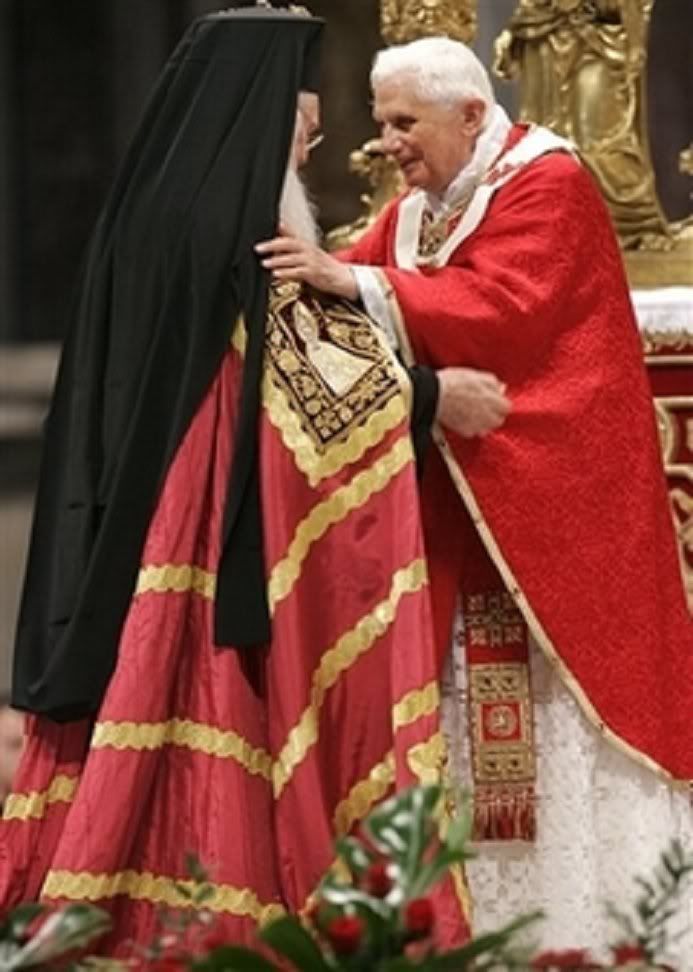
From early in the Christian era, the Church of Rome has celebrated Saints Peter and Paul as its founders in the faith of Christ and its holy patrons.
Recalling the antiquity and significance of this feast last weekend was the Bishop of Rome, Benedict XVI, in two important homilies: first, on the eve of the Solemnity, the Roman Pontiff formally opened the year dedicated to the Apostle who met Jesus on the road to Damascus, to mark the 200th anniversary of his birth; and on the feast itself - both times in the highly significant presence of Bartholomew I, Patriarch of Rome's sister Church of Constantinople, and representatives of other Christian churches and ecclesial communities.
The initiative is not only celebratory. For Christians, the Pope explained, Paul is not a figure of the past but a teacher who speaks to us daily through his letters.
As even Pier Paolo Pasolini had intuited when he planned to make a film about the Apostle. He would situate him in our time because "he is here, today, among us", it is we whom he addresses, and "it is our society that he decries and loves, threatens and forgives, attacks and tenderly embraces".
And Paul's presence today is that of a man whose faith is "not a theory or an opinion about God and the world (but) the impact of God's love on his heart": As he always does in his commentary on liturgical texts and observances, Benedict XVI goes to the core and explains the essential in words that are simple but profound.
Therefore, it is Paul's experience which best points to Christians the way of unity, which is found in service to the truth - even if this "is paid for with suffering" in a world pervaded by the power of lies.
To the presence of Paul, the tradition of the Church of Rome has always joined that of Peter "who became a citizen of Rome for always". Not through any distant devotion, but because the two apostles were "the founders of a new kind of city, which must always form itself anew in the midst of the human city" threatened by sin.
The mission of the two apostles, in different ways, was to open the Church to the 'ecumene', namely to the entire known world at the time, without any barriers.
Thus, Rome "must make the faith visible to the whole world," and "the permanent mission of Peter" is to insure that the Church - which is never identified "with one nation, one culture or one State" - may reach out to all of mankind and truly be "the Church of all" beyond every division.
In the continuity of the apostolic tradition, this is the task of the Church of Rome.
======================================================================
In the recurring paradox of the Italian media generally ignoring the Church- and religion-specific aspects of events involving the Pope and the Vatican, not even the fact that the religious holiday on Sunday, June 29, was also the patronal feast day of Rome itself, merited a story in any of the major national newspapers. With the exception of a brief report by Andrea Tornielli in Il Giornale, no one reported the opening of the Pauline Year nor the Sunday Mass at St. Peter's. Notwithstanding the newsworthy and historic participation of Patriarch Bartholomew in both events!
Avvenire's media critic, writing under the pseudonym Rosso Malpelo, takes note of this today as one of two 'trends' that characterized reporting on the Church in the Italian MSM yesterday:
Some details say a lot. Unita [official newspaper of the Italian Communist Party] has this 5-column headline: "Cardinal Vallini, a pastor at St. John Lateran". And in the story itself, it points out several times that Pope Benedict had said this was a 'pastoral choice'.
What did it want to imply? That the Diocese of Rome had now passed form 'the political Cardinal' (Ruini) who had a missionary involvement in an open dialog with Italian society on values, to the 'pastoral' leadership of Cardinal Vallini. That now the Chruch of Rome had a Pastor! So what was the Vicar of Rome earlier? A farmer? A hunter? A fisherman? Bishops are pastors by definition! But then, such is the fashion of cliches in the media.....
In Il Sole 24 Ora, the new Vicar of Rome is 'the jurist', and La Stampa's headline notes the passage from "the warrior bishop [Ruini] who was too intelligent and powerful" to "a great juridical expert". [The headline is for a story by Stampa's Marco Tosatti who wrote an admiring profile of Cardinal Ruini, somewhat at the expense of Cardinal Bertone who is portrayed as having been wary, to say the least, of Cardinal Ruini's influence.]
Thankfully, newspaper stories are by their nature 'ephemeral', from the Greek ephemerides - what they say today will be forgotten tomorrow.
But something else more troubling. Yesterday, except in Il Giornale, there was nothing about the papal celebration of the Feast of Saints Peter and Paul, with the prayers, profession of faith and apostolic blessings said together by Benedict XVI and Bartholomew I, the Patriarch of Constantinople.
Rather, all the newspapers carried stories about the new uniform for the Vatican police, while Stampa outdid everyone with a belated 6-column story, with four photographs and the headline "New look, or rather retro: Ratzinger's revolution" about the Pope's liturgical vestments.
A maliciously 'light' piece, this one, confected from frou-frou and news snippets already reported so many times. And what about the 1000 years of history since Rome and Constantinople split? [Or the 2000 years since the birth of Paul!] 'Tiresome trivia and who cares!' is what our media seem to be saying!
[Modificato da TERESA BENEDETTA 02/07/2008 01:50] |
 02/07/2008 04:19 02/07/2008 04:19 |
|
| | | OFFLINE | | Post: 14.144 | Registrato il: 28/08/2005
| Utente Gold | |
|
  THE ECUMENISM OF PAPA RATZINGER
THE ECUMENISM OF PAPA RATZINGER
by SALVATORE MAZZA
Translated from
the 7/1/08 issue of

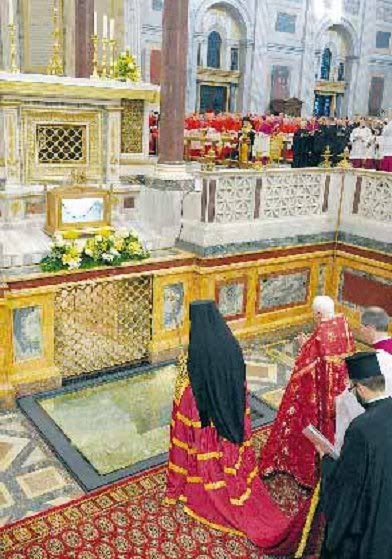 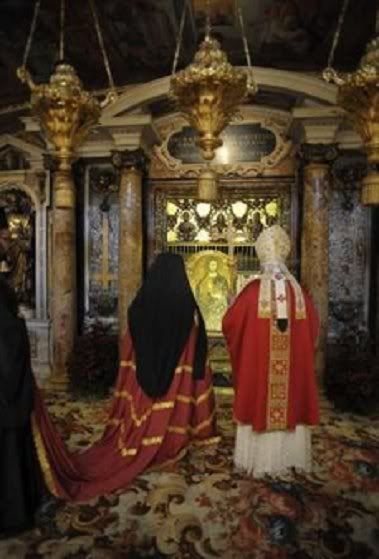 The ultimate 'ad-limina' visits: Benedict XVI and Bartholomew I at the tombs of St. Paul (left) and St. Peter.
The ultimate 'ad-limina' visits: Benedict XVI and Bartholomew I at the tombs of St. Paul (left) and St. Peter.
There is no precedent in memory to the concentration of ecumenical gestures that we witnessed in the first two days of the Pauline Year. Singly, nothing that has not been done before. But the gestures have impressed themselves for their number, and even more, for their quality.
Although undoubtedly the limelight was inevitably on the Ecumenical Patriarch of Constantinople Bartholomew I - up to the intense emotion of the final blessing he gave at St. peter's Basilica on Sunday - none of the guests for the momentous weekend was, so to speak, left outside the Pauline Door.
Everyone who should be there was in the solemn procession that entered the special door 'created' for the occasion Saturday night: the churches of the West and East, Anglicans and Protestants. No Christian church or ecclesial comunity was not represented.
Thinking back on the weekend, there were two impressions that dominated.
The first has to do directly with the event that sparked this assembly of all the Christian denominations at the tomb of St. Paul.
"We are gathered not to reflect on a past that is irrevocably gone," Pope Benedict said at the inaugural Vespers on Saturday evening. "Paul speaks to us today. And that is why I proclaimed this special Pauline Year - so we can listen to him and learn from him as our teacher, about faith and truth, in which are rooted the motivations for unity among the disciples of Christ."
Truly strong motivations indeed, and as Benedict XVI sensed in promoting the ecumenical context for the Pauline Year, widely shared, as indicated by the response from the other Christian groups. This has to be appreciated not only from their solid presence in Rome this weekend, but above all, from the extraordinary variety of ecumenical initiatives which the mere proclamation of the Pauline Year has already inspired everywhere.
The sign of that 'desire' for unity, of a 'nostalgia' that all the many obstacles along the way - old and new, big and small, as they may be - have not managed to suppress.
The second impression has to do with the state of ecumenism just a little over three years since Benedict XVI became Pope.
On April 20, 2005, at his first Eucharistic concelebration with the cardinals after the Conclave, perhaps not a few people thought that his statement that he would make it his 'primary commitment' to "work unsparingly towards the reconstitution of full and visible unity among all the followers of Christ" was nothing more than an obligatory statement of good intentions.
Or not much more, at any rate: He may have been serious, sure and sincere about 'his ambition.. and his compelling duty" but he faced a mine-filled territory.
And yet, what one cannot fail to note after 38 months is that when he said then that he was conscious that "manifestations of good intentions would not be enough", he has really succeeded to translate that awareness into a long series of 'concrete gestures' that are "capable of reaching the spirit and affecting consciences"
That is what we witnessed this weekend. Surprising gestures, as everything that involves the Pope and the Patriarch of Constantinople seem to be. Certainly the reciprocal sympathy they have established betwen them since their first meeting plays a role.
Or small, almost unnoticed signs, like that of the Anglican primate who sent a personal representative to Rome, because he himself had to keep track of a schism in the Anglican Communion that threatened to become formal during the weekend.
And in this Year of Paul, Papa Ratzinger's already long list of ecumenical milestones is bound to grow even longer.
[Modificato da TERESA BENEDETTA 02/07/2008 04:55] |
 02/07/2008 06:18 02/07/2008 06:18 |
|
| | | OFFLINE | | Post: 14.145 | Registrato il: 28/08/2005
| Utente Gold | |
|
EX-SSPX 'WARD' COMMUNITY
BACK TO FULL COMMUNION WITH ROME
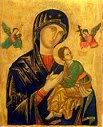 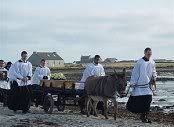 
The icon of Our Lady of Perpetual help is the Redemptorist Order's trademark;
photo shows the Trans-Alpines at their island monastery north of Scotland;
and their Stella Maris coat-of-arms.
Just as the SSPX were making news this week by continuing their seeming intransigence to the Vatican, one of their former 'wards' announced their good news today (July 1) - as both Father Z and Rorate caeli have reported. Of course, every stray sheep that comes back to the flock is cause for rejoicing. Imagine what joy it must be for the Holy Father! Bless him for this, and for all his kind wisdom...
One will appreciate this new development even more after having read the Transalpine Redemptorists' newsletter last April when they announced they were seeking to 'make up' with Rome. Lori posted it last April in page 99 of NEWS ABOUT THE CHURCH.
freeforumzone.leonardo.it/discussione.aspx?idd=354498&p=99
======================================================================
Very relevant news made public by the Transalpine Redemptorists, children of Saint Alphonsus Maria Liguori, and helped throughout their history by Archbishop Marcel Lefebvre and the Priestly Fraternity of Saint Pius X (FSSPX / SSPX):
1 July, 2008
Feast of the Precious Blood
My dear friends,
I am happy to inform you that last June 18th, before Cardinal Castrillon and the members of the Pontifical Commission Ecclesia Dei in Rome, I humbly petitioned the Holy See on my own behalf and on behalf of the monastery council for our priestly suspensions to be lifted.
On June 26th I received word that the Holy See had granted our petition. All canonical censures have been lifted.
Our community now truly rejoices in undisputed and peaceful posession of Communion with the Holy See because our priests are now in canonical good standing.
We are very grateful to our Holy Father Pope Benedict XVI for issuing, last July, the Motu Proprio Summorum Pontificum which called us to come into undisputed and peaceful Communion with him.
Now we have that undisputed communion! It is a pearl of great price; a treasure hidden in the field; a sweetness that cannot be imagined by those who have not tasted it or who have not known it, now for many years. Its value cannot be fully expressed in earthly language and therefore we hope that all traditional priests who have not yet done so, will answer Pope Benedict's call to enjoy the grace of peaceful and undisputed communion with him.
Believe us, the price to pay is nothing; even all the angry voices that have shouted against us and calumniated us are as nothing when weighed in the scales against undisputed communion with the Vicar of Christ; others have died for it; what are raucous voices?
We publicly thank all those souls who have prayed for us over the last months; some of you have truly stormed heaven for us. You have kept us afloat. We are deeply grateful. Especially we thank that priest who was unknown to us, until June 16th when he wrote in fraternal support. Where did he come from? Why us? But he told us of the number of Masses, Offices, prayers and sacrifices he had personally said for us; he had also enlisted the prayers of contemplatives and Third Order societies and had a great number of people fervently praying for us with an abundance of prayers. We were amazed! Thank you Father! Thank you also to that brave person who, so kindly wrote to us to say that if he said any more prayers for us he would be floating! What wonderful people! Thank you!
Looking to the future, the next stage will be to have our community canonically erected. So please, dear friends, keep praying for us, there will be many crosses to bear; but they will be yokes sweetened by the grace of these last days.
We assure you all of our very best wishes.
Your devoted servant,
Fr. Michael Mary, C.SS.R.
Vicar General
 |
 02/07/2008 14:44 02/07/2008 14:44 |
|
| | | OFFLINE | | Post: 14.148 | Registrato il: 28/08/2005
| Utente Gold | |
|
GENERAL AUDIENCE TODAY:
BENEDICT XVI STARTS
CATECHESIS CYCLE ON ST. PAUL
A full translation of the catechesis has been posted in AUDIENCE & ANGELUS TEXTS.
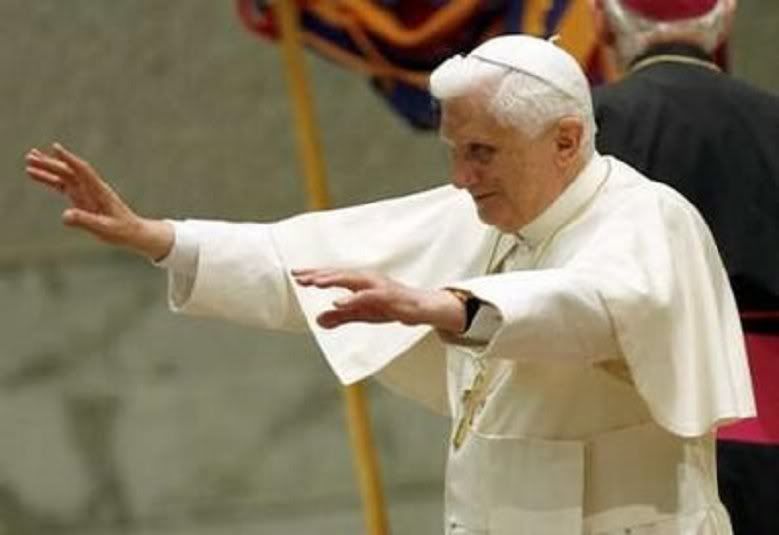
The Holy Father today began a catechetical cycle on the figure and teachings of St. Paul. Here is the synthesis he gave in English:
Last Sunday, the Solemnity of the Apostles Peter and Paul, marked the beginning of a Year dedicated to the figure and teaching of the Apostle Paul.
Today’s Audience begins a new series of catecheses aimed at understanding more deeply the thought of Saint Paul and its continuing relevance.
Paul, as we know, was a Jew, and consequently a member of a distinct cultural minority in the Roman Empire. At the same time, he spoke Greek, the language of the wider Hellenistic culture, and was a Roman citizen.
Paul’s proclamation of the Risen Christ, while grounded in Judaism, was marked by a universalist vision and it was facilitated by his familiarity with three cultures. He was thus able to draw from the spiritual richness of contemporary philosophy, and Stoicism in particular, in his preaching of the Gospel.
The crisis of traditional Greco-Roman religion in Paul’s time had also fostered a greater concern for a personal experience of God. As we see from his sermon before the Areopagus in Athens (cf. Acts 17:22ff.), Paul was able to appeal to these currents of thought in his presentation of the Good News. Against this broad cultural background, Paul developed his teaching, which we will explore in the catecheses of this Pauline Year.
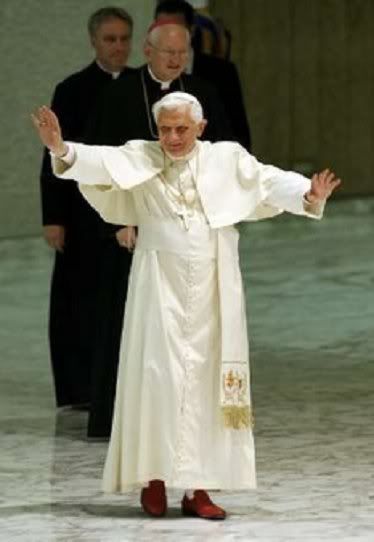 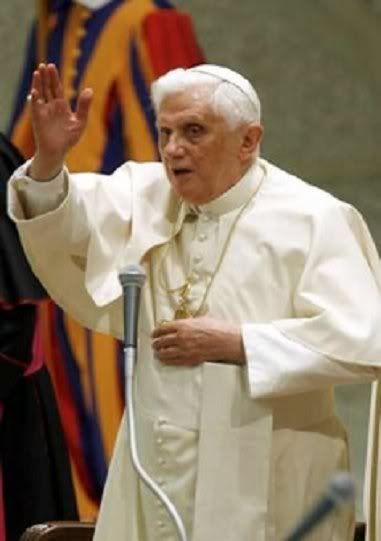 In the Year of St. Paul:
In the Year of St. Paul:
Let us turn to him
to 'learn the faith and learn Christ'

Vatican City, Jully 2 (AsiaNews) – A year to understand “what St Paul has to say to Christians today” and “learn the faith, learn Christ and finally learn the right way.”
In the first audience after the solemn opening of the Year dedicated to the bimillenary of the birth of the Apostle to the Gentiles, the last before the start of the summer break (Wednesday meetings will resume on 13 August), Benedict XVI inaugurated a series of reflections that he wants to dedicate to the “exalted and almost inimitable figure” of Saint Paul, “example of total dedication to the lord and His Church as well as of great openness to humanity and its cultures.”
The Pope said Paul, like Christianity, “cannot be understood without placing him against the Jewish and pagan background of his time.” Against this backdrop Benedict XVI explained to the 8,000 people in aula Paolo VI the cultural context in which Paul lived and worked.
“We must place ourselves,” said the Holy Father, “in the world of 2,000 years age. Under many aspects today’s socio-cultural context is not that much different from that of that time.”
First of all, Paul “comes from a culture that was certainly in the minority, that of the People of Israel.” In the ancient world in Rome, Jews were at best 3 per cent of the population.
“Like today their beliefs and lifestyle clearly set them apart from their environment. This can lead to mockery or admiration, something which Paul experienced as well.”
For instance, the Pope noted that “Cicero despised their religion and even the city of Jerusalem,” whereas Nero’s wife Poppaea was considered a “sympathiser" and even Julius Caesar had recognised their particularism.
Paul also lived immersed in the Hellenistic culture “which at the time was a shared heritage at least in the Eastern Mediterranean,” in a political situation in which the Roman Empire “guaranteed stability and peace from Britain to Egypt, and provided (a common fabric for super partes unification.”
And if the “universalistic vision that was typical of the Christian Paul owes its basic impulse to Jesus,” the cultural preparation provided by his environment must be remembered so much so that he was seen as man of three cultures: Jewish, Greek and Roman.”
Similarly, the Pope noted that the prevailing stoic philosophy influenced Paul as well. Among Stoic philosophers like Seneca one can find “the highest values of humanity and wisdom which are naturally received in Christianity;” for instance the doctrine of the universe as a uniquely harmonious body, equality for all, and self-control.
Today Benedict XVI moves into the Pope’s summer residence in Castel Gandolfo. He will remain there until July 11 when he will leave to celebrate World Youth Day in Sydney (Australia). He will return to Castel Gandolfo on July, and on the 28th, he will travel to Brixen-Bressanone (South Tyrol) for his annual summer 'rest' until August 11.
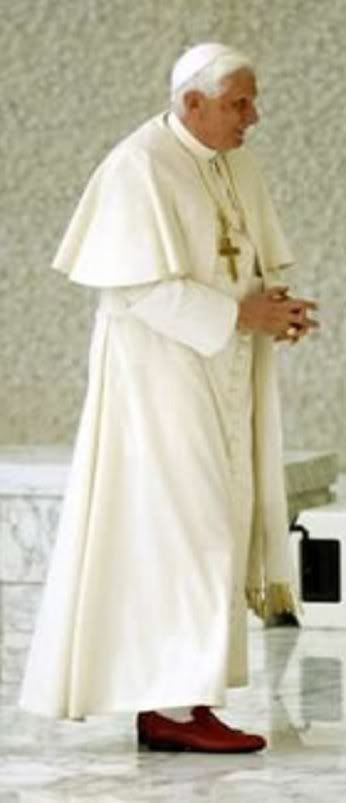
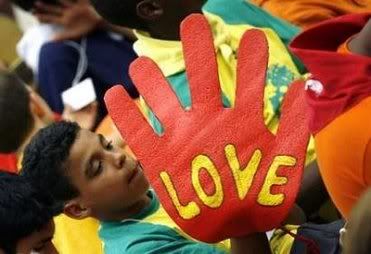 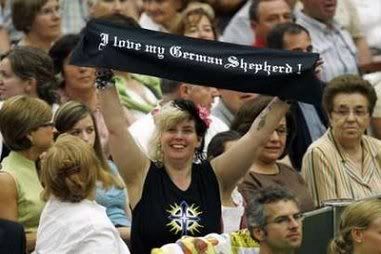 NB: Because of his trip to Sydney and his summer vacation, the next General Audience will be held on August 13, after the Holy Father returns from Bressanone.
NB: Because of his trip to Sydney and his summer vacation, the next General Audience will be held on August 13, after the Holy Father returns from Bressanone.
=====================================================================
I must admit I am still trying to process the giddily breathtaking prospect of a whole year's catechesis by Benedict XVI on St. Paul! Wow and wow again, exponentially! Just imagine, every Wednesday, we are treated to the best lecture anywhere in the world on theology, philosophy and general culture.
Benedict's catecheses on the Apostles, the early Christians and the Fathers of the Church may yet be one of his most seminal contributions to the cause of ecumenism. Even if these lessons are directed primarily at us Catholics, everything he speaks of about the Church before 1054 is shared by all Christians! It's hard to imagine a more accessible and pleasurable way for a Christian to get a basic education on everything that Chistianity stands for.
Besides a way to make sure that every Roman Catholic priest and if possible, every Roman Catholic catechist has access to the Pope's catechesis, imagine if some Christian Bill Gates could fund a way to make these catecheses available to the ministers and faithful of all the other Christian confessions as well!
Benedict invests the word Magisterium - root word magis [more, to a greater degree], magister [chief, master, teacher, director, adviser] - with all the positive connotations it can possibly have.
BENEDICTUS QUI VENIT IN NOMINE DOMINI!
[Modificato da TERESA BENEDETTA 03/07/2008 02:57] |
 02/07/2008 17:32 02/07/2008 17:32 |
|
| | | OFFLINE | | Post: 14.150 | Registrato il: 28/08/2005
| Utente Gold | |
|
     Pauline Year:
Pauline Year:
The Ecumenical Dream of Pope Benedict
The Successor of Peter and the Patriarch of Constantinople have each proclaimed a special jubilee year
dedicated to the great apostle Paul.
Benedict XVI's The stated objective: "To create the unity of the 'catholica', of the Church formed
from Jews and pagans, of the Church of all peoples"
by Sandro Magister

ROMA, July 2, 2008 – In the photo, Benedict XVI and Bartholomew I, the Patriarch of Constantinople, are praying in front of the tomb of the apostle Paul, beneath the main altar of the Roman basilica of Saint Paul's Outside the Walls. [The glass case on the altar contains links of the chain traditionally believed to have bound Paul before he was executed; the tomb itself is underneath the altar and may be glimpsed by visitors through the glass-covered opening in the floor.]
On the vigil of the Solemnity of Saints Peter and Paul, they inaugurated a special jubilee year dedicated to the apostle Paulmarking the 200th anniversary of his birth, whih historians say took place bteween 7 and 10 A.D.
[It must be noted that the Catholic Pauline Year, from June 28, 2008 to June 29, 2009, is different from the Pauline Year declared by Bartholomew for the Orthodox Church which coincides with the calendar year 2008.]
Benedict XVI formally announced this special jubilee year on June 28, 2007. This is how he explained the event to the faithful gathered in St. Peter's Square, before the Angelus on the feast of Saints Peter and Paul this year:
"Rome will be the center for this special jubilee - in particular, the Basilica of Saint Paul's Outside the Walls, and the place of his martyrdom, at Tre Fontane. But it will also involve the entire Church, beginning from Tarsus, the city of Paul's birth, and the other Pauline sites that are the destination of pilgrimages in modern-day Turkey, as also in the Holy Land, and on the island of Malta, where the Apostle landed after a shipwreck and sowed the fertile seed of the Gospel.
"In reality, the horizon of the Pauline Year cannot be anything but universal, because Saint Paul was, par excellence, the apostle of those who with respect to the Jews were 'far off' and who 'have become near by the blood of Christ' (cf. Eph. 2:13). For this reason, still today, in a world that has become 'smaller', but where very many have still not encountered the Lord Jesus, the jubilee of Saint Paul invites all Christians to be missionaries of the Gospel.
"This missionary dimension must always be accompanied by that of unity, represented by Saint Peter, the 'rock' upon which Jesus Christ built his Church. As the liturgy emphasizes, the charisms of the two great apostles are complementary for the edification of the one People of God, and Christians cannot give valid testimony to Christ if they are not united among themselves."
Universal and ecumenical. A church that is "catholic" and "one." This is the twofold horizon that the bishop of Rome and the Patriarch of Constantinople have for the Pauline Year, proclaimed separately by their respective churches.
At the Mass celebrated on the feast of Saints Peter and Paul, the two Apostolic Successors entered St. Peter's basilica together, went up to the altar, preceded by a Latin deacon and by an Orthodox one, each carrying the book of the Gospels; together they listened to the chanting of the Gospel in Latin and in Greek; they both delivered a homily, first the Patriarch and then the Pope, after a brief introduction by the latter; together they recited the Creed, the Nicene-Constantinopolitan symbol in the original Greek, according to the liturgical use of the Byzantine Churches; they exchanged the kiss of peace, and at the end they blessed the faithful together.
Never before now – after almost a thousand years of schism between East and West – had a liturgy so visibly oriented to unity been celebrated by the Bishop of Rome and by the patriarch of Constantinople.
[I am curious why not one report - not even Magister - has referred so far to the 2004 Mass of Saints Peter and Paul, which followed exactly the same program - at least according to the liturgical 'scenario' published at the time by the Office of Pontifical Liturgical Celebrations, which can be read here in English:
www.vatican.va/news_services/liturgy/2004/documents/ns_lit_doc_20040629_rite...
The only difference in the description is that the Pope greeted the Patriarch in the Pieta Chapel, not outside the door of St. Peter's as Benedict did. Not having read any accounts of it nor seen any video of the event, the only difference one can imagine would be that John Paul II was already movement-constrained by illness at the time.
The English translation of the homilies delivered that day by Bartholomew I and John Paul II are on
www.vatican.va/holy_father/john_paul_ii/homilies/2004/documents/hf_jp-ii_hom_20040629_sts-peter-paul...
The relationship with the Protestant communities remains deeper in the shadows for now. But the Pauline Year could be rich in significance for the dialogue with these communities as well. The leading thinkers of the Reformation – from Luther and Calvin to Karl Barth, Rudolph Bultmann, and Paul Tillich – elaborated their thought beginning above all with the Letter of Paul to the Romans.
And the contribution that the Pauline Year could make to dialogue with the Jews is no less relevant. Paul was an observant Jew and a rabbi, before falling down blinded by Christ on the road to Damascus. And his conversion to the Risen One never meant, for him, breaking with his original faith. [????? Not with the faith in one God, surely, but what about Jesus as the Messiah and as God - which certainly Jews rejected then as they do now - and with Mosaic/rabbinical regulations and rituals????]
The promise of God to Abraham and the covenant on Sinai were always for Paul one and the same with the "new and eternal" covenant sealed by the blood of Jesus. Joseph Ratzinger has written memorable pages on this unity between the Old and New Testament, in his book Jesus of Nazareth.
[ Magister then posts translations of the Vespers homily delivered by Benedict XVI on June 28, 2008, and links to the original (Italian)homilies by Patriarch Bartholomew and Pope Benedict On Sunday. Translations of all these were posted this weekend ON THIS fORUM inHOMILIES, DISCOURSES, MESSAGES.
For a more general overview - although far from comprehensive - of Pope Benedict's ecumenical program, see the article by Salvatore Mazza from Avvenire, a translation of which is posted a few items above this on this page.
I certainly think the Pauline Year deserves far more from Magister than this perfunctory report that seems more like just putting himself down on the record that "Hey, I didn't miss repoting on the opening of this jubilee at all!"]
[Modificato da TERESA BENEDETTA 02/07/2008 21:43] |
 02/07/2008 18:06 02/07/2008 18:06 |
|
| | | OFFLINE | | Post: 14.151 | Registrato il: 28/08/2005
| Utente Gold | |
|
 A translation of Tornielli's blog today
A translation of Tornielli's blog today:
I have learned from reliable sources that, contrary to what has emerged in some articles, the response of the SSPX to the letter of Cardinal Castrillon was in fact not negative. The Cardinal is pleased about it, he has responded to Fellay, and he has sent on the SSPX letter to Benedict XVI. The Lefebvrians want more time beyond the June 30 deadline given [by Castrillon], but - it seems - they want to comply with the five points.
====================================================================
  
The U.S. District of the SSPX has published an English text of the Lefebvrians' reply to the Vatican, from the society's news service, DICI, as follows:
CONCERNING THE ULTIMATUM
of Cardinal Castrillon Hoyos
Released on July 1, 2008 from DICI
On June 4, 2008, at the request of Cardinal Dario Castrillon Hoyos, President of the Pontifical Commission Ecclesia Dei, the Superior General of the Society of St. Pius X, Bishop Bernard Fellay, went to Rome accompanied the Second Assistant General, Fr. Alain-Marc Nely.
During the interview, he was given a memorandum in the form of an ultimatum, demanding an answer by the end of the month of June. On June 23, contrary to the established custom, the Italian daily Il Giornale revealed the existence of the ultimatum and, the next day, published its content in its online edition. In the days following, the information was broadcasted by all of the international press. Thus, to the urgency of the ultimatum was added media pressure.
Cardinal Castrillon Hoyos’ document expressed five demands: besides a positive answer requested before the end of June, the Society of St. Pius X, in the person of its General Superior, had to commit itself (1) “to give a response proportionate to the Pope’s generosity”; (2) “to avoid any public comment which would not respect the person of the Holy Father and would have a negative impact upon ecclesial charity;” (3) “to avoid claiming a magisterium superior to the Holy Father’s and not to set the Society in opposition to the Church;” (4) “to demonstrate its will to act in all honesty and ecclesial charity, and in the respect of the authority of the Vicar of Christ.”
We must observe that the very general — not to say vague — character of the demands singularly contrasts with the urgency of the ultimatum. The conditions seem to be meant to obtain an atmosphere favorable to a further dialogue, rather than imply any precise commitment on definite issues.
The Society of St. Pius X wishes that the dialogue be on the doctrinal level and take into accounts all the issues, which, if they were evaded, might jeopardize a canonical status hastily set up. The SSPX considers that the preliminary withdrawal of the 1988 decrees of excommunication would foster serenity in the dialogue.
The SSPX does not claim the exercise of a magisterium superior to the Holy Father’s, nor does it seek to oppose the Church. Following in the footsteps of its founder, it wants to hand down what it has received, namely “ what has always been believed everywhere and by all.”
It claims as its own the profession of faith addressed by Archbishop Lefebvre to Paul VI on September 24, 1975: “Jesus Christ has entrusted to His Vicar the charge of confirming his brethren in the faith, and has asked him to make sure that every bishop faithfully keep the deposit of the faith, according to St. Paul’s recommendation to Timothy.”
In a letter to Pope Benedict XVI, dated June 26, 2008, Bishop Fellay answered in this sense. Cardinal Castrillon Hoyos acknowledged receipt of the letter the next day.
Until further details are available, we will make no comment.
I must once again note that the home page of the SSPX U.S. district carries the following statement in a box on the upper right-hand corner of its homepage, www.sspx.org/index.htm
with a picture of Benedict XVI:
The Society of St. Pius X professes filial devotion and loyalty to Pope Benedict XVI, the Successor of Saint Peter and the Vicar of Christ.
The priests of the SSPX pray for the intentions of the Holy Father and the welfare of the local Ordinary at every Mass they celebrate.
Is the US district acting autonomously in this regard?
I know too little of SSPX relations with the Vatican - and therefore with the one Church which is also the official Church - before Benedict XVI became Pope, but even the most suspicious 'loyalist' to the Church would have to conclude that the above response most certainly does not slam the door shut to 'reconciliation'.
The one 'positive' statement in the response was this:
The SSPX does not claim the exercise of a magisterium superior to the Holy Father’s, nor does it seek to oppose the Church.
which would seem to be an agreement in principle to all four conditions (with the exception of the deadline) that all have to do with respecting the Magisterium of the Church and the authority of the Pope who is the principal voice of the Magisterium.
I do not know whether, outside of the US District's open statement of loyalty to Benedict XVI, the SSPX has ever been as 'explicit' on this issue, since on the contrary, Mons. Fellay's own last reported public sermon was very defiant - "They want us to shut up - we won't shut up!"
However, the fact that the SSPX did set down such a statement in black and white cannot have been a step not amply deliberated on - and is therefore a public commitment of sorts.
Fellay needs time, one must conclude, to get all his people into line. But he can't expect a unanimous consensus - people like Bishop Williamson seem to be too far gone to hope much from. So it's really up to him to decide whether it's worth pandering to the few unrelenting extremists to prolong the entire sect's continued exclusion from the fold of the one Roman Catholic Church.
Of course, the statement released by DIC makes two audacious assumptions that are, to say the least, highly questionable:
Following in the footsteps of its founder, it wants to hand down what it has received, namely “what has always been believed everywhere and by all.”
It implies it is up to them, the SSPX, to decide “what has always been believed everywhere and by all" - which is tantamount to saying they get to decide what the Magisterium is, or should be, in their opinion. If everyone thought that, there would be no Church but 1.2 billion separate self-constituted, single-membership churchlets!
And what about this?
It claims as its own the profession of faith addressed by Archbishop Lefebvre to Paul VI on September 24, 1975: “Jesus Christ has entrusted to His Vicar the charge of confirming his brethren in the faith, and has asked him to make sure that every bishop faithfully keep the deposit of the faith, according to St. Paul’s recommendation to Timothy.”
Now, they are lecturing the Vicar of Christ on his duties! Well, the 'deposit of the faith' also includes what the Church decides at its great Councils.
And yet, by 1988, when Lefebvre's excommunication more or less 'formalized' a schism, his line by then - after he had signed an agreement protocol with Cardinal Ratzinger that he reneged on at the last minute - was that they do not recognize the teachings of Vatican-II (which Lefebvre had freely signed as a Council member) nor any Pope who would uphold its teachings!
The extremists of the right, it must be repeated, are just as bad as those of the left - all of them driven by an arrogance they do not seem to be aware of, and best encapsulated by those dissidents who name themselves 'We are the Church'.
[Modificato da TERESA BENEDETTA 02/07/2008 20:34] |
 02/07/2008 22:46 02/07/2008 22:46 |
|
| | | OFFLINE | | Post: 14.153 | Registrato il: 28/08/2005
| Utente Gold | |
|
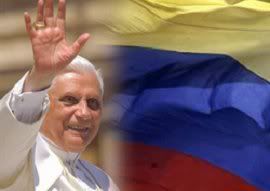 Pope calls for end to violence
Pope calls for end to violence
and extortion in Colombia

Bogotá, Jul 2, 2008 (CNA) - Pope Benedict XVI has sent a video-taped message to the bishops of Colombia in which he calls for an end to the “violence, kidnapping and extortion” that is affecting so many in that country. The bishops are currently gathered to celebrate the 100th anniversary of the founding of their conference.
The video was played during the Colombian bishops’ General Assembly this week. The Pope said he was mindful of their effort to be "men of harmony" and of their "continual exhortations for an end to the violence, kidnapping, and extortion which affect so many sons and daughters of that beloved land.”
“I fervently pray to God for an end to these situations which have caused so much suffering, and for a stable and just peace in Colombia, in a climate of hope and prosperity,” he said.
The Pontiff also said he joined the bishops in celebrating the 100th anniversary of the founding of their conference, praising them for their “eloquent testimony of apostolic zeal.”
The anniversary, the Pope said, is a “providential occasion for considering the testimony of those who came before us and for helping our brothers and sisters to strengthen their friendship with Jesus Christ, to receive his Word with purity of heart, to celebrate the sacraments with joy and to serve others with enthusiasm, especially those most in need, bringing them a message of peace, justice and reconciliation.”
Referring to the challenges facing the Church in Colombia, Benedict XVI assured the bishops of his "prayers and spiritual closeness in the efforts you are making to ensure the Gospel rings out in all parts of Colombian territory, through initiatives in the fields of pastoral care in education and in universities, and in the concern you show for the imprisoned, the sick, the elderly, indigenous peoples, workers, the displaced, the young and families."
"In the certainty that you are laying solid foundations for a promising future, and for the good of the whole Church", he continued, "I encourage your to redouble your attention towards priests, seminarians, missionaries and religious, and to give renewed impetus to the various formational programmes for catechists, lay people and pastoral care workers."
[Modificato da TERESA BENEDETTA 02/07/2008 22:48] |
|
|
|
|